Physiology for Emergency Care: Short Answer Quiz
VerifiedAdded on 2023/06/11
|31
|5191
|114
AI Summary
This short answer quiz tests your knowledge on physiology for emergency care. It covers topics such as the physiological effects of chemoreceptor stimulation, altered immunological reactions, and the body's response to a reduction in blood pressure. The quiz also includes a case study on a patient in hypovolemic shock.
Contribute Materials
Your contribution can guide someone’s learning journey. Share your
documents today.
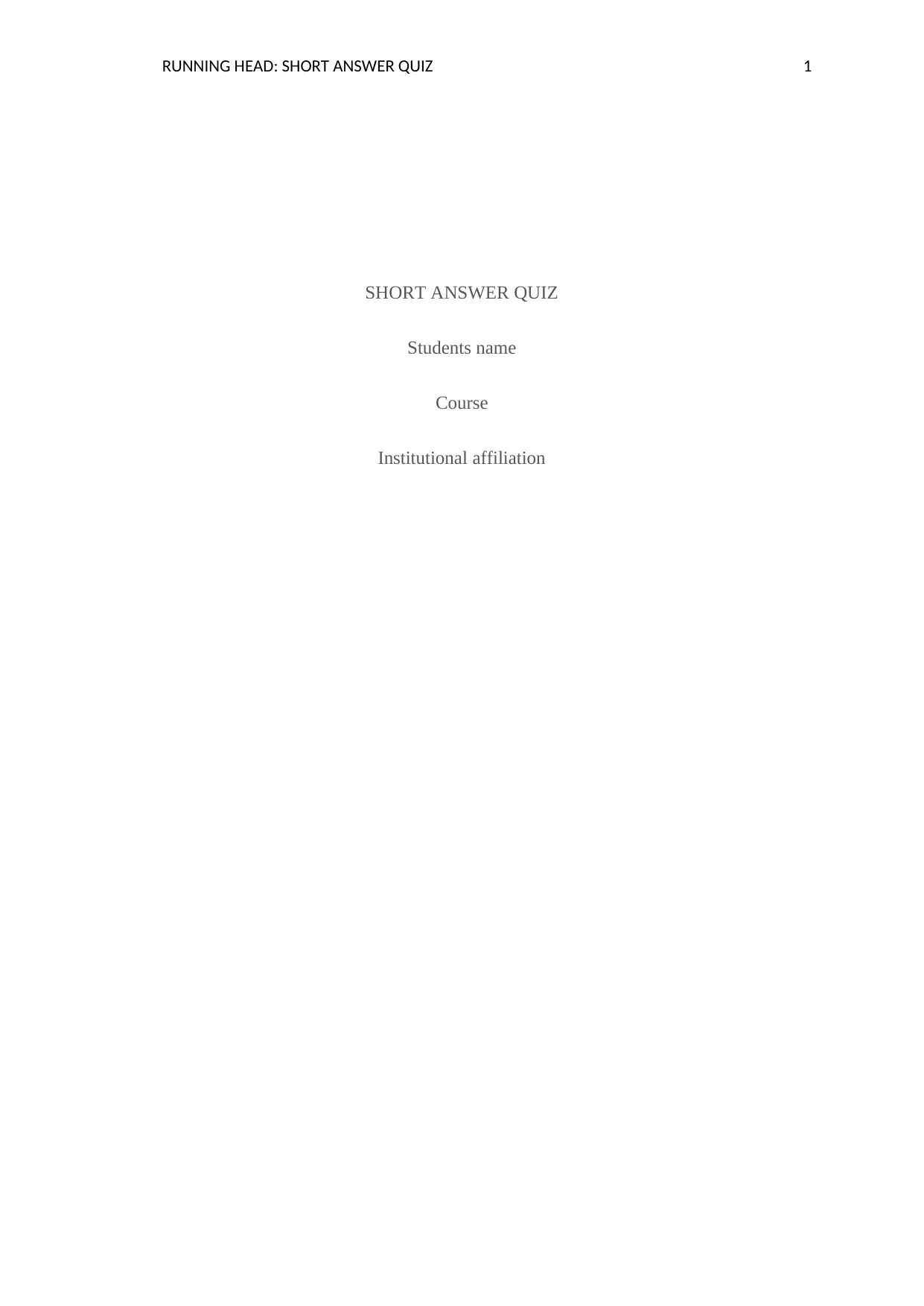
RUNNING HEAD: SHORT ANSWER QUIZ 1
SHORT ANSWER QUIZ
Students name
Course
Institutional affiliation
SHORT ANSWER QUIZ
Students name
Course
Institutional affiliation
Secure Best Marks with AI Grader
Need help grading? Try our AI Grader for instant feedback on your assignments.
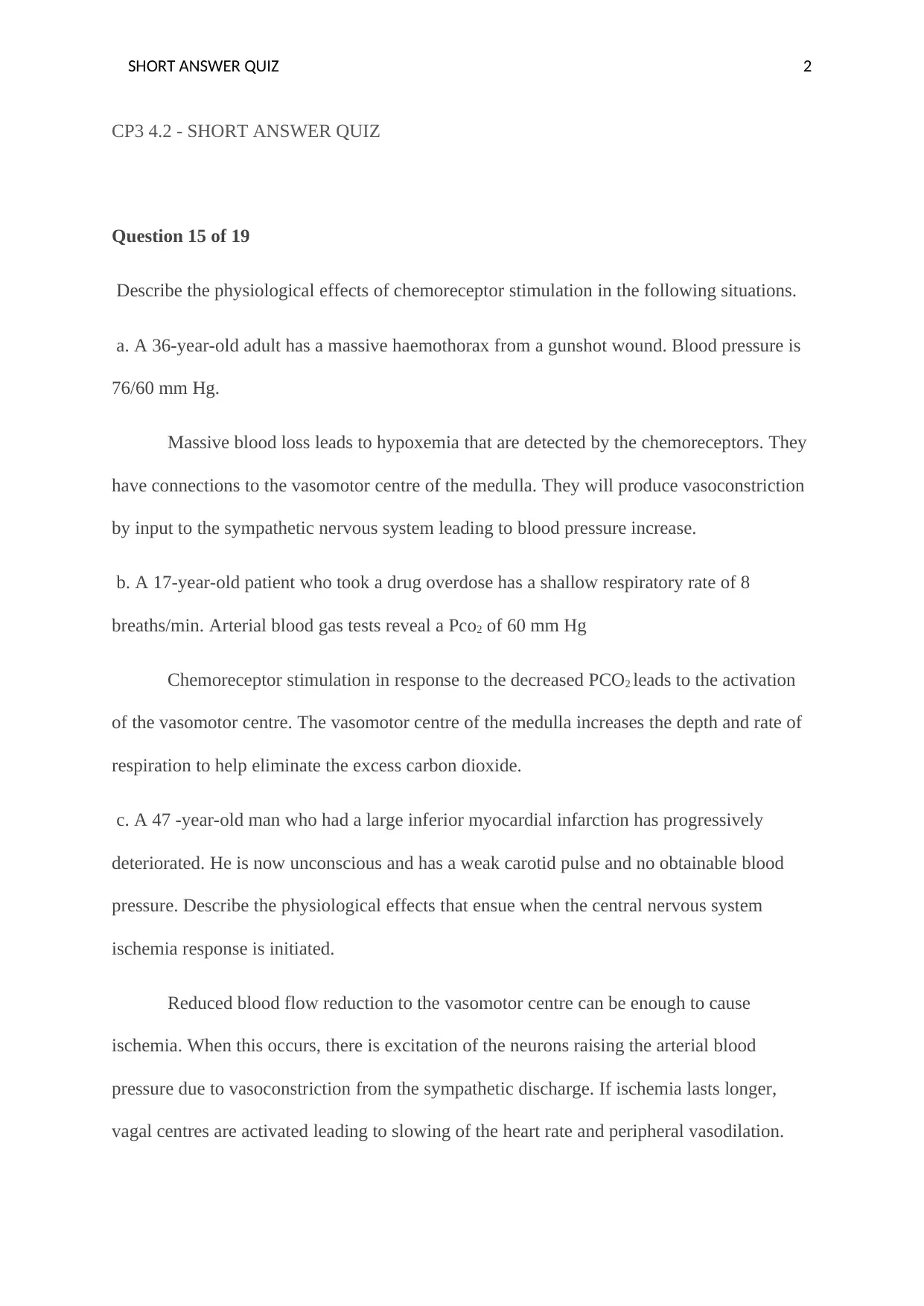
SHORT ANSWER QUIZ 2
CP3 4.2 - SHORT ANSWER QUIZ
Question 15 of 19
Describe the physiological effects of chemoreceptor stimulation in the following situations.
a. A 36-year-old adult has a massive haemothorax from a gunshot wound. Blood pressure is
76/60 mm Hg.
Massive blood loss leads to hypoxemia that are detected by the chemoreceptors. They
have connections to the vasomotor centre of the medulla. They will produce vasoconstriction
by input to the sympathetic nervous system leading to blood pressure increase.
b. A 17-year-old patient who took a drug overdose has a shallow respiratory rate of 8
breaths/min. Arterial blood gas tests reveal a Pco2 of 60 mm Hg
Chemoreceptor stimulation in response to the decreased PCO2 leads to the activation
of the vasomotor centre. The vasomotor centre of the medulla increases the depth and rate of
respiration to help eliminate the excess carbon dioxide.
c. A 47 -year-old man who had a large inferior myocardial infarction has progressively
deteriorated. He is now unconscious and has a weak carotid pulse and no obtainable blood
pressure. Describe the physiological effects that ensue when the central nervous system
ischemia response is initiated.
Reduced blood flow reduction to the vasomotor centre can be enough to cause
ischemia. When this occurs, there is excitation of the neurons raising the arterial blood
pressure due to vasoconstriction from the sympathetic discharge. If ischemia lasts longer,
vagal centres are activated leading to slowing of the heart rate and peripheral vasodilation.
CP3 4.2 - SHORT ANSWER QUIZ
Question 15 of 19
Describe the physiological effects of chemoreceptor stimulation in the following situations.
a. A 36-year-old adult has a massive haemothorax from a gunshot wound. Blood pressure is
76/60 mm Hg.
Massive blood loss leads to hypoxemia that are detected by the chemoreceptors. They
have connections to the vasomotor centre of the medulla. They will produce vasoconstriction
by input to the sympathetic nervous system leading to blood pressure increase.
b. A 17-year-old patient who took a drug overdose has a shallow respiratory rate of 8
breaths/min. Arterial blood gas tests reveal a Pco2 of 60 mm Hg
Chemoreceptor stimulation in response to the decreased PCO2 leads to the activation
of the vasomotor centre. The vasomotor centre of the medulla increases the depth and rate of
respiration to help eliminate the excess carbon dioxide.
c. A 47 -year-old man who had a large inferior myocardial infarction has progressively
deteriorated. He is now unconscious and has a weak carotid pulse and no obtainable blood
pressure. Describe the physiological effects that ensue when the central nervous system
ischemia response is initiated.
Reduced blood flow reduction to the vasomotor centre can be enough to cause
ischemia. When this occurs, there is excitation of the neurons raising the arterial blood
pressure due to vasoconstriction from the sympathetic discharge. If ischemia lasts longer,
vagal centres are activated leading to slowing of the heart rate and peripheral vasodilation.

SHORT ANSWER QUIZ 3
Question 16 of 19
A 65-year-old alcoholic man states that he had a sudden onset of vomiting. The emesis
contains bright red blood, and he continues to vomit. Vital signs are blood pressure - 94/78
mm Hg - pulse - 132 beats/min (bpm) and respirations - 28 breaths/min. Describe the effects
of the following three hormonal mechanisms, which will be activated.
a. Adrenal medullary mechanism
The medulla produces primarily the catecholamines epinephrine, norepinephrine and
dopamine (Wong, 2006). During physiologic, physical or environmental stress for example
bleeding in this case, the body perceives a threat to normal homeostatic balance and initiates
a response via the hypothalamus (Barrett, Barman, Boitano, & Brooks, 2009). A sympathetic
nervous discharge will travel through the spinal cord and the sympathetic preganglionic
neuron to synapse with chromaffin cells of the adrenal medulla to release mainly epinephrine
(De Diego, Gandia, & Garcia, 2008). Epinephrine has various effects on target organs
including increasing the heart rate, blood pressure, vessel constriction to divert blood from
non-essential organs like skin to more essential organs like heart and brain, increasing the
metabolic rate and pupillary dilatation just to name a few (Waugh & Grant, 2010).
b. Renin-angiotensin-aldosterone mechanism
Bleeding causes a reduction in renal blood flow which is detected by the
juxtaglomerular cells of the kidney (Moon, 2013). They secrete renin, which enzymatically
turns angiotensinogen to angiotensin 1. Angiotensin 1 is then turned by angiotensin
converting enzyme to angiotensin 2 a potent vasoconstrictor that increases the peripheral
resistance hence the blood pressure. It also stimulates the adrenal cortex to produce
Question 16 of 19
A 65-year-old alcoholic man states that he had a sudden onset of vomiting. The emesis
contains bright red blood, and he continues to vomit. Vital signs are blood pressure - 94/78
mm Hg - pulse - 132 beats/min (bpm) and respirations - 28 breaths/min. Describe the effects
of the following three hormonal mechanisms, which will be activated.
a. Adrenal medullary mechanism
The medulla produces primarily the catecholamines epinephrine, norepinephrine and
dopamine (Wong, 2006). During physiologic, physical or environmental stress for example
bleeding in this case, the body perceives a threat to normal homeostatic balance and initiates
a response via the hypothalamus (Barrett, Barman, Boitano, & Brooks, 2009). A sympathetic
nervous discharge will travel through the spinal cord and the sympathetic preganglionic
neuron to synapse with chromaffin cells of the adrenal medulla to release mainly epinephrine
(De Diego, Gandia, & Garcia, 2008). Epinephrine has various effects on target organs
including increasing the heart rate, blood pressure, vessel constriction to divert blood from
non-essential organs like skin to more essential organs like heart and brain, increasing the
metabolic rate and pupillary dilatation just to name a few (Waugh & Grant, 2010).
b. Renin-angiotensin-aldosterone mechanism
Bleeding causes a reduction in renal blood flow which is detected by the
juxtaglomerular cells of the kidney (Moon, 2013). They secrete renin, which enzymatically
turns angiotensinogen to angiotensin 1. Angiotensin 1 is then turned by angiotensin
converting enzyme to angiotensin 2 a potent vasoconstrictor that increases the peripheral
resistance hence the blood pressure. It also stimulates the adrenal cortex to produce

SHORT ANSWER QUIZ 4
aldosterone, a hormone whose principle action is salt and water retention (Moon, 2013). This
aims to increase blood volume, cardiac output, and blood pressure.
c. Vasopressin mechanism
Vasopressin is released from the posterior pituitary in response to sympathetic activity
and hyperosmolarity of blood. It is released into circulation to exert its effects on the kidneys
and the blood vessels. In the blood vessels it is a powerful vasoconstrictor reducing which in
this case would raise the blood pressure by increasing the peripheral resistance. In the kidney
it promotes water reabsorption maintaining blood volume, cardiac output and in turn blood
pressure.
Complete the following paragraph using the following words/ phrases:
cellular acidosis and impaired cellular function
coagulation
complement, coagulation and kallikrein/kinin
endothelium
endotoxins and inflammatory mediators
hypotension and hypoperfusion
interstitial
oedema formation, cardiovascular instability and clotting abnormalities
organ
permeable
systemic vascular resistance
thrombus
vascular endothelial
aldosterone, a hormone whose principle action is salt and water retention (Moon, 2013). This
aims to increase blood volume, cardiac output, and blood pressure.
c. Vasopressin mechanism
Vasopressin is released from the posterior pituitary in response to sympathetic activity
and hyperosmolarity of blood. It is released into circulation to exert its effects on the kidneys
and the blood vessels. In the blood vessels it is a powerful vasoconstrictor reducing which in
this case would raise the blood pressure by increasing the peripheral resistance. In the kidney
it promotes water reabsorption maintaining blood volume, cardiac output and in turn blood
pressure.
Complete the following paragraph using the following words/ phrases:
cellular acidosis and impaired cellular function
coagulation
complement, coagulation and kallikrein/kinin
endothelium
endotoxins and inflammatory mediators
hypotension and hypoperfusion
interstitial
oedema formation, cardiovascular instability and clotting abnormalities
organ
permeable
systemic vascular resistance
thrombus
vascular endothelial
Secure Best Marks with AI Grader
Need help grading? Try our AI Grader for instant feedback on your assignments.
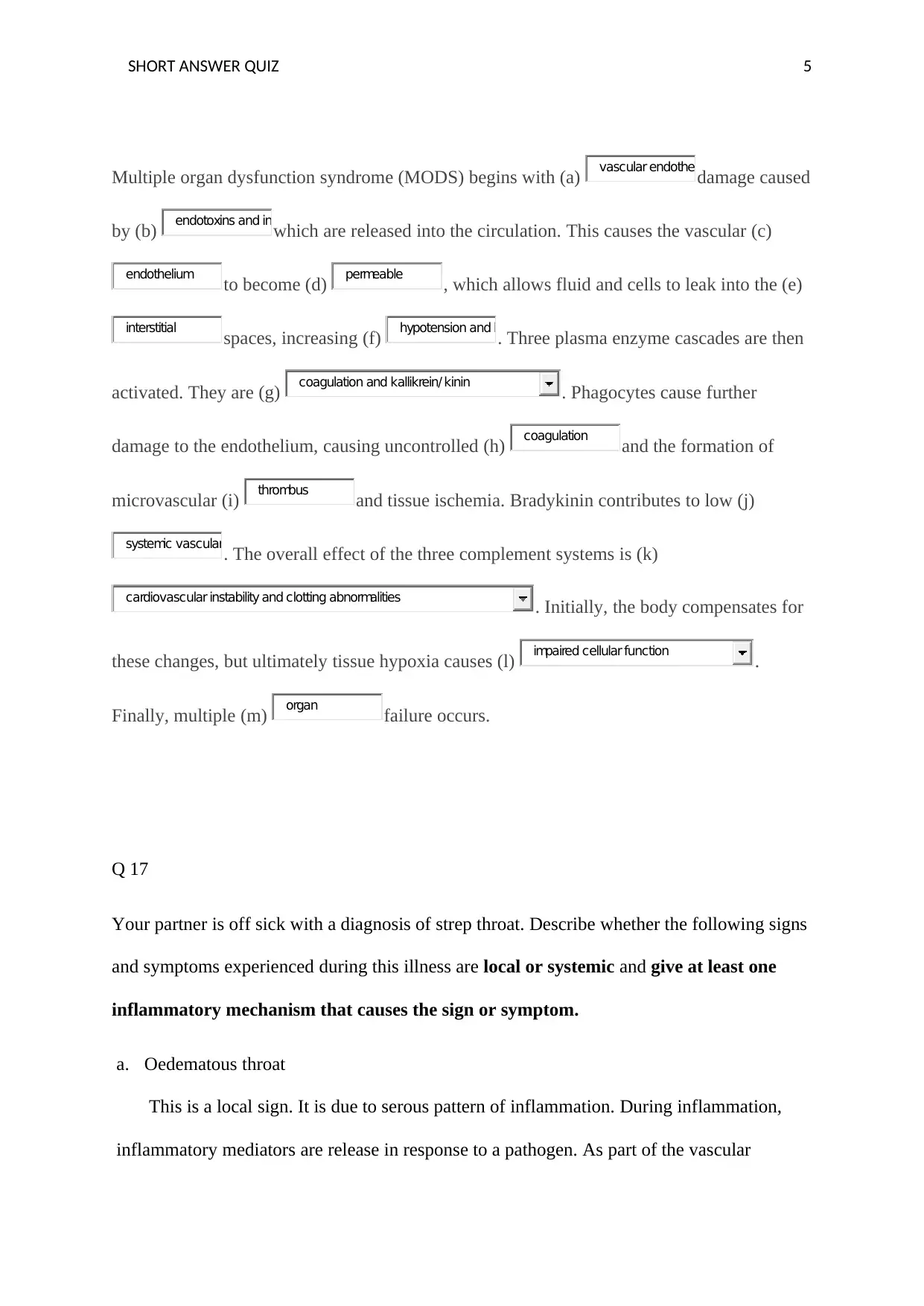
SHORT ANSWER QUIZ 5
Multiple organ dysfunction syndrome (MODS) begins with (a) damage caused
by (b) which are released into the circulation. This causes the vascular (c)
to become (d) , which allows fluid and cells to leak into the (e)
spaces, increasing (f) . Three plasma enzyme cascades are then
activated. They are (g) . Phagocytes cause further
damage to the endothelium, causing uncontrolled (h) and the formation of
microvascular (i) and tissue ischemia. Bradykinin contributes to low (j)
. The overall effect of the three complement systems is (k)
. Initially, the body compensates for
these changes, but ultimately tissue hypoxia causes (l) .
Finally, multiple (m) failure occurs.
Q 17
Your partner is off sick with a diagnosis of strep throat. Describe whether the following signs
and symptoms experienced during this illness are local or systemic and give at least one
inflammatory mechanism that causes the sign or symptom.
a. Oedematous throat
This is a local sign. It is due to serous pattern of inflammation. During inflammation,
inflammatory mediators are release in response to a pathogen. As part of the vascular
vascular endothe
endotoxins and in
endothelium permeable
interstitial hypotension and h
coagulation and kallikrein/ kinin
coagulation
thrombus
systemic vascular
cardiovascular instability and clotting abnormalities
impaired cellular function
organ
Multiple organ dysfunction syndrome (MODS) begins with (a) damage caused
by (b) which are released into the circulation. This causes the vascular (c)
to become (d) , which allows fluid and cells to leak into the (e)
spaces, increasing (f) . Three plasma enzyme cascades are then
activated. They are (g) . Phagocytes cause further
damage to the endothelium, causing uncontrolled (h) and the formation of
microvascular (i) and tissue ischemia. Bradykinin contributes to low (j)
. The overall effect of the three complement systems is (k)
. Initially, the body compensates for
these changes, but ultimately tissue hypoxia causes (l) .
Finally, multiple (m) failure occurs.
Q 17
Your partner is off sick with a diagnosis of strep throat. Describe whether the following signs
and symptoms experienced during this illness are local or systemic and give at least one
inflammatory mechanism that causes the sign or symptom.
a. Oedematous throat
This is a local sign. It is due to serous pattern of inflammation. During inflammation,
inflammatory mediators are release in response to a pathogen. As part of the vascular
vascular endothe
endotoxins and in
endothelium permeable
interstitial hypotension and h
coagulation and kallikrein/ kinin
coagulation
thrombus
systemic vascular
cardiovascular instability and clotting abnormalities
impaired cellular function
organ
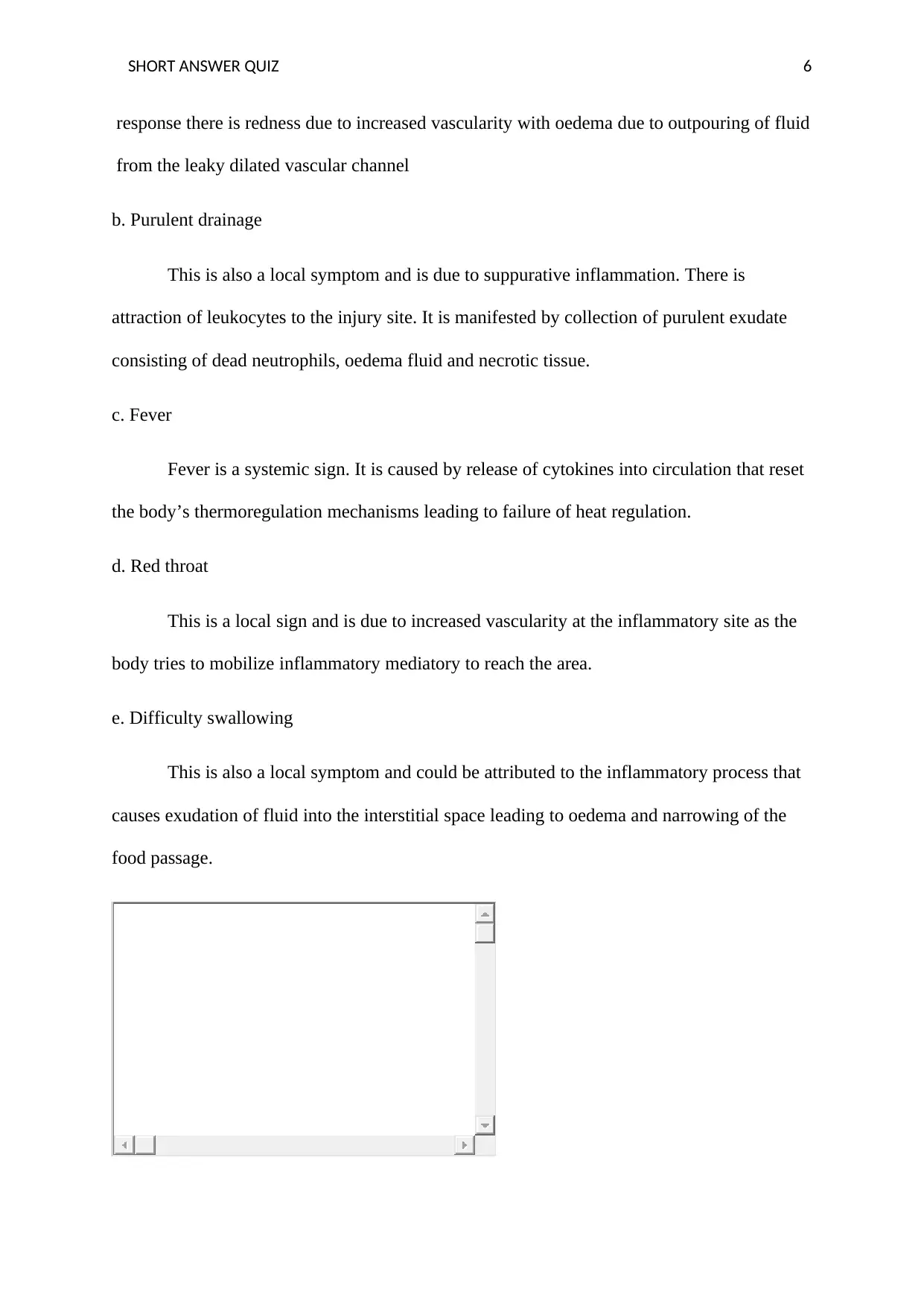
SHORT ANSWER QUIZ 6
response there is redness due to increased vascularity with oedema due to outpouring of fluid
from the leaky dilated vascular channel
b. Purulent drainage
This is also a local symptom and is due to suppurative inflammation. There is
attraction of leukocytes to the injury site. It is manifested by collection of purulent exudate
consisting of dead neutrophils, oedema fluid and necrotic tissue.
c. Fever
Fever is a systemic sign. It is caused by release of cytokines into circulation that reset
the body’s thermoregulation mechanisms leading to failure of heat regulation.
d. Red throat
This is a local sign and is due to increased vascularity at the inflammatory site as the
body tries to mobilize inflammatory mediatory to reach the area.
e. Difficulty swallowing
This is also a local symptom and could be attributed to the inflammatory process that
causes exudation of fluid into the interstitial space leading to oedema and narrowing of the
food passage.
response there is redness due to increased vascularity with oedema due to outpouring of fluid
from the leaky dilated vascular channel
b. Purulent drainage
This is also a local symptom and is due to suppurative inflammation. There is
attraction of leukocytes to the injury site. It is manifested by collection of purulent exudate
consisting of dead neutrophils, oedema fluid and necrotic tissue.
c. Fever
Fever is a systemic sign. It is caused by release of cytokines into circulation that reset
the body’s thermoregulation mechanisms leading to failure of heat regulation.
d. Red throat
This is a local sign and is due to increased vascularity at the inflammatory site as the
body tries to mobilize inflammatory mediatory to reach the area.
e. Difficulty swallowing
This is also a local symptom and could be attributed to the inflammatory process that
causes exudation of fluid into the interstitial space leading to oedema and narrowing of the
food passage.

SHORT ANSWER QUIZ 7
Question 19 of 19
For each statement below, note which one of three types of altered immunological reaction
has occurred: allergy, autoimmunity, or isoimmunity.
a. You are dispatched to a private residence to care for a 46-year-old woman who began to
experience dyspnea, a swollen face, and hives after taking a penicillin tablet prescribed by her
dentist.
This is an allergic reaction.
b. You are transferring a patient to a dialysis centre for care after his body rejected his kidney
transplant.
This is an isoimmunty reaction
c. You notice that your eyes water and get puffy and your hands become very red and itchy
when you wear latex gloves at work.
This is an allergic reaction.
d. Your patient, a 30-year-old woman, is having chest pain. The family tells you she has
systemic lupus erythematosus with cardiac and pulmonary involvement.
This is an autoimmune reaction.
Question 19 of 19
For each statement below, note which one of three types of altered immunological reaction
has occurred: allergy, autoimmunity, or isoimmunity.
a. You are dispatched to a private residence to care for a 46-year-old woman who began to
experience dyspnea, a swollen face, and hives after taking a penicillin tablet prescribed by her
dentist.
This is an allergic reaction.
b. You are transferring a patient to a dialysis centre for care after his body rejected his kidney
transplant.
This is an isoimmunty reaction
c. You notice that your eyes water and get puffy and your hands become very red and itchy
when you wear latex gloves at work.
This is an allergic reaction.
d. Your patient, a 30-year-old woman, is having chest pain. The family tells you she has
systemic lupus erythematosus with cardiac and pulmonary involvement.
This is an autoimmune reaction.
Paraphrase This Document
Need a fresh take? Get an instant paraphrase of this document with our AI Paraphraser
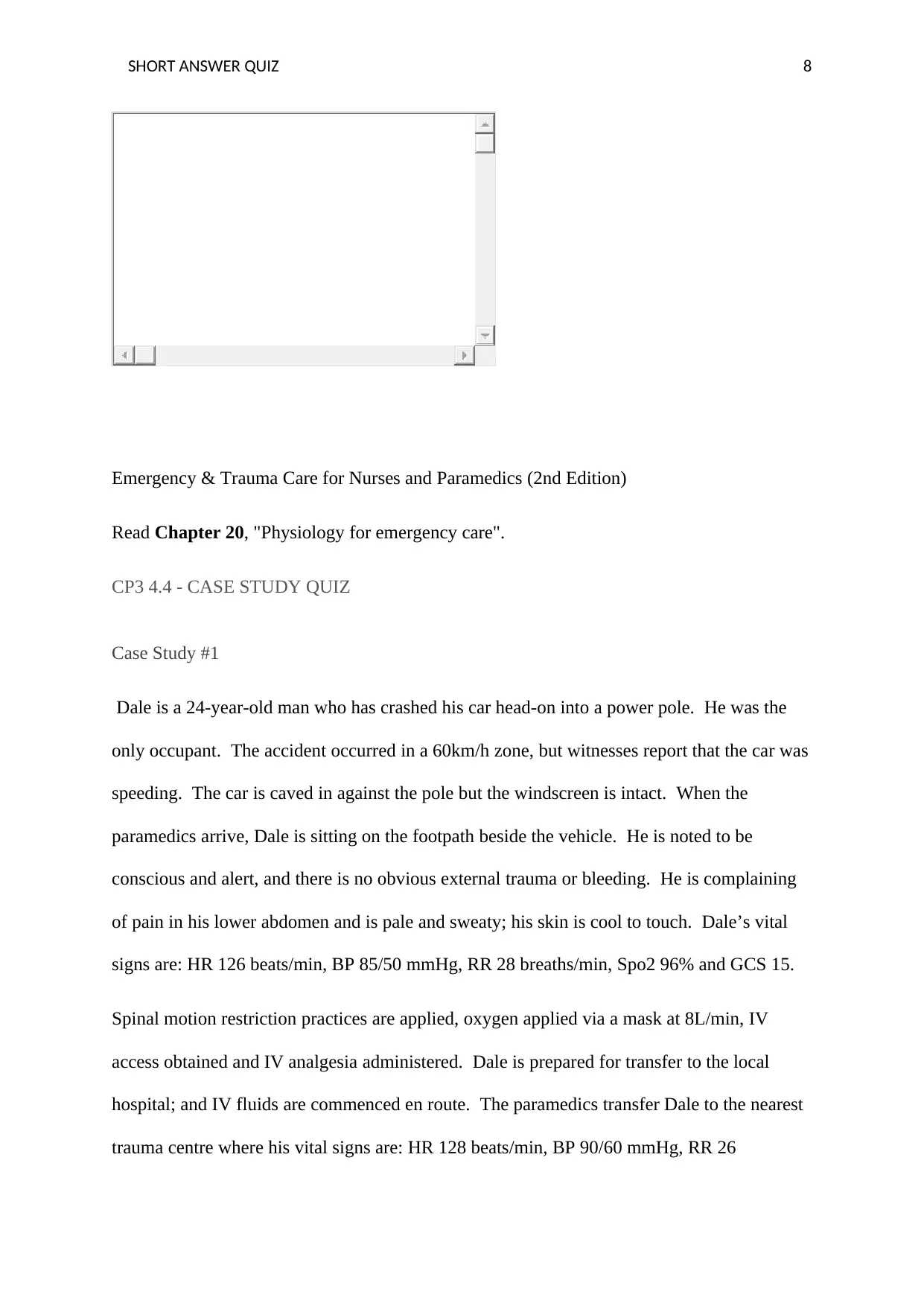
SHORT ANSWER QUIZ 8
Emergency & Trauma Care for Nurses and Paramedics (2nd Edition)
Read Chapter 20, "Physiology for emergency care".
CP3 4.4 - CASE STUDY QUIZ
Case Study #1
Dale is a 24-year-old man who has crashed his car head-on into a power pole. He was the
only occupant. The accident occurred in a 60km/h zone, but witnesses report that the car was
speeding. The car is caved in against the pole but the windscreen is intact. When the
paramedics arrive, Dale is sitting on the footpath beside the vehicle. He is noted to be
conscious and alert, and there is no obvious external trauma or bleeding. He is complaining
of pain in his lower abdomen and is pale and sweaty; his skin is cool to touch. Dale’s vital
signs are: HR 126 beats/min, BP 85/50 mmHg, RR 28 breaths/min, Spo2 96% and GCS 15.
Spinal motion restriction practices are applied, oxygen applied via a mask at 8L/min, IV
access obtained and IV analgesia administered. Dale is prepared for transfer to the local
hospital; and IV fluids are commenced en route. The paramedics transfer Dale to the nearest
trauma centre where his vital signs are: HR 128 beats/min, BP 90/60 mmHg, RR 26
Emergency & Trauma Care for Nurses and Paramedics (2nd Edition)
Read Chapter 20, "Physiology for emergency care".
CP3 4.4 - CASE STUDY QUIZ
Case Study #1
Dale is a 24-year-old man who has crashed his car head-on into a power pole. He was the
only occupant. The accident occurred in a 60km/h zone, but witnesses report that the car was
speeding. The car is caved in against the pole but the windscreen is intact. When the
paramedics arrive, Dale is sitting on the footpath beside the vehicle. He is noted to be
conscious and alert, and there is no obvious external trauma or bleeding. He is complaining
of pain in his lower abdomen and is pale and sweaty; his skin is cool to touch. Dale’s vital
signs are: HR 126 beats/min, BP 85/50 mmHg, RR 28 breaths/min, Spo2 96% and GCS 15.
Spinal motion restriction practices are applied, oxygen applied via a mask at 8L/min, IV
access obtained and IV analgesia administered. Dale is prepared for transfer to the local
hospital; and IV fluids are commenced en route. The paramedics transfer Dale to the nearest
trauma centre where his vital signs are: HR 128 beats/min, BP 90/60 mmHg, RR 26
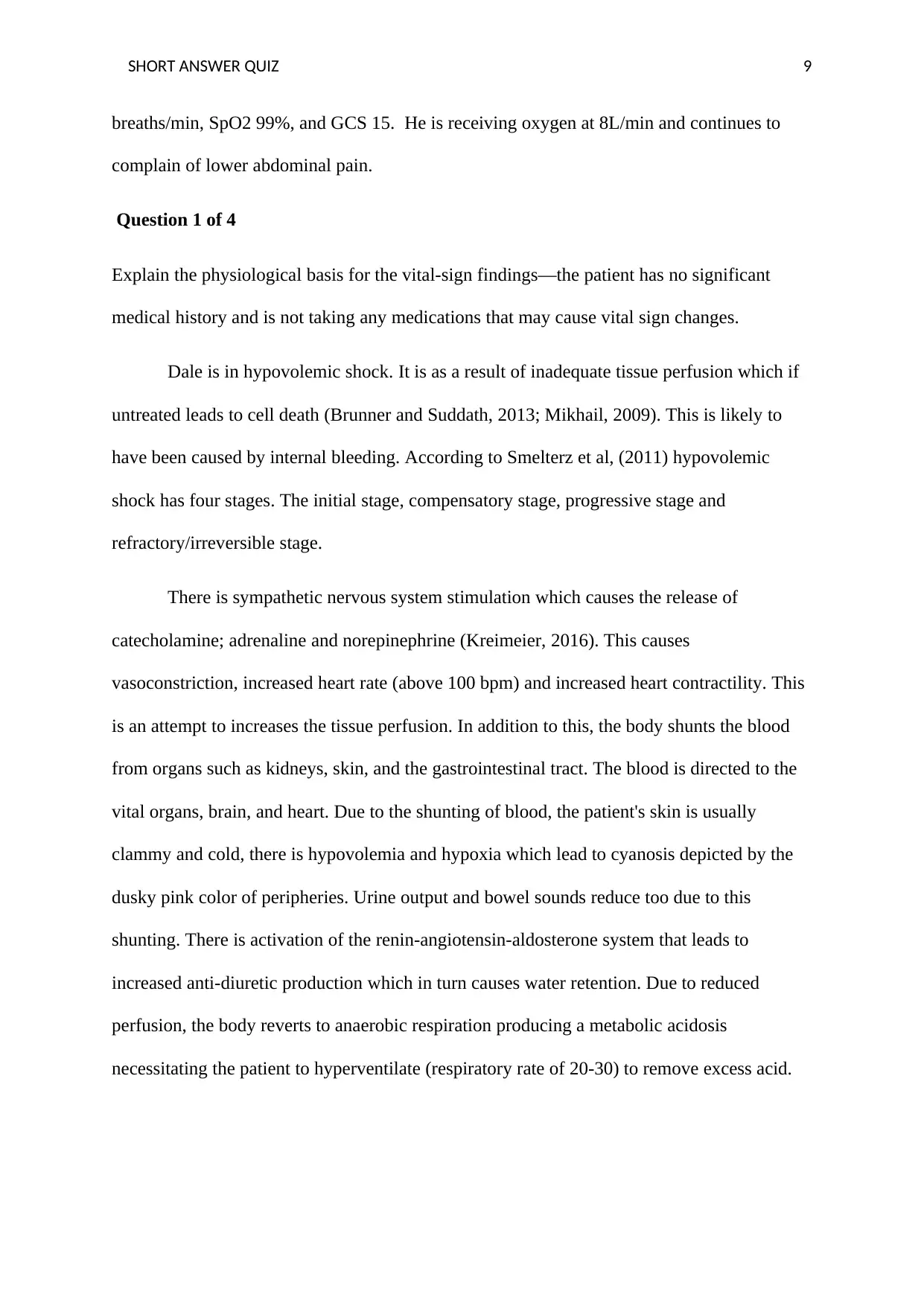
SHORT ANSWER QUIZ 9
breaths/min, SpO2 99%, and GCS 15. He is receiving oxygen at 8L/min and continues to
complain of lower abdominal pain.
Question 1 of 4
Explain the physiological basis for the vital-sign findings—the patient has no significant
medical history and is not taking any medications that may cause vital sign changes.
Dale is in hypovolemic shock. It is as a result of inadequate tissue perfusion which if
untreated leads to cell death (Brunner and Suddath, 2013; Mikhail, 2009). This is likely to
have been caused by internal bleeding. According to Smelterz et al, (2011) hypovolemic
shock has four stages. The initial stage, compensatory stage, progressive stage and
refractory/irreversible stage.
There is sympathetic nervous system stimulation which causes the release of
catecholamine; adrenaline and norepinephrine (Kreimeier, 2016). This causes
vasoconstriction, increased heart rate (above 100 bpm) and increased heart contractility. This
is an attempt to increases the tissue perfusion. In addition to this, the body shunts the blood
from organs such as kidneys, skin, and the gastrointestinal tract. The blood is directed to the
vital organs, brain, and heart. Due to the shunting of blood, the patient's skin is usually
clammy and cold, there is hypovolemia and hypoxia which lead to cyanosis depicted by the
dusky pink color of peripheries. Urine output and bowel sounds reduce too due to this
shunting. There is activation of the renin-angiotensin-aldosterone system that leads to
increased anti-diuretic production which in turn causes water retention. Due to reduced
perfusion, the body reverts to anaerobic respiration producing a metabolic acidosis
necessitating the patient to hyperventilate (respiratory rate of 20-30) to remove excess acid.
breaths/min, SpO2 99%, and GCS 15. He is receiving oxygen at 8L/min and continues to
complain of lower abdominal pain.
Question 1 of 4
Explain the physiological basis for the vital-sign findings—the patient has no significant
medical history and is not taking any medications that may cause vital sign changes.
Dale is in hypovolemic shock. It is as a result of inadequate tissue perfusion which if
untreated leads to cell death (Brunner and Suddath, 2013; Mikhail, 2009). This is likely to
have been caused by internal bleeding. According to Smelterz et al, (2011) hypovolemic
shock has four stages. The initial stage, compensatory stage, progressive stage and
refractory/irreversible stage.
There is sympathetic nervous system stimulation which causes the release of
catecholamine; adrenaline and norepinephrine (Kreimeier, 2016). This causes
vasoconstriction, increased heart rate (above 100 bpm) and increased heart contractility. This
is an attempt to increases the tissue perfusion. In addition to this, the body shunts the blood
from organs such as kidneys, skin, and the gastrointestinal tract. The blood is directed to the
vital organs, brain, and heart. Due to the shunting of blood, the patient's skin is usually
clammy and cold, there is hypovolemia and hypoxia which lead to cyanosis depicted by the
dusky pink color of peripheries. Urine output and bowel sounds reduce too due to this
shunting. There is activation of the renin-angiotensin-aldosterone system that leads to
increased anti-diuretic production which in turn causes water retention. Due to reduced
perfusion, the body reverts to anaerobic respiration producing a metabolic acidosis
necessitating the patient to hyperventilate (respiratory rate of 20-30) to remove excess acid.
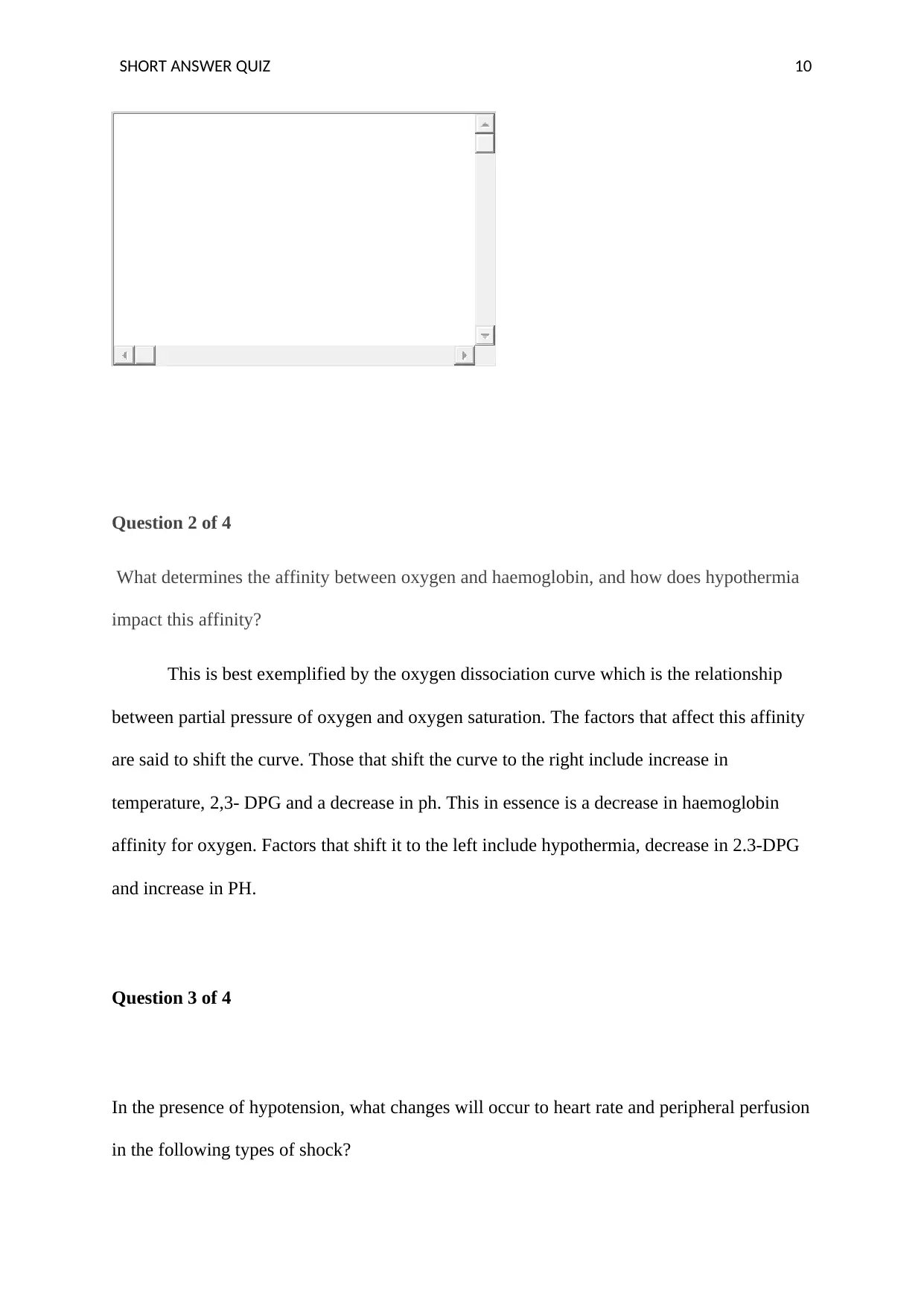
SHORT ANSWER QUIZ 10
Question 2 of 4
What determines the affinity between oxygen and haemoglobin, and how does hypothermia
impact this affinity?
This is best exemplified by the oxygen dissociation curve which is the relationship
between partial pressure of oxygen and oxygen saturation. The factors that affect this affinity
are said to shift the curve. Those that shift the curve to the right include increase in
temperature, 2,3- DPG and a decrease in ph. This in essence is a decrease in haemoglobin
affinity for oxygen. Factors that shift it to the left include hypothermia, decrease in 2.3-DPG
and increase in PH.
Question 3 of 4
In the presence of hypotension, what changes will occur to heart rate and peripheral perfusion
in the following types of shock?
Question 2 of 4
What determines the affinity between oxygen and haemoglobin, and how does hypothermia
impact this affinity?
This is best exemplified by the oxygen dissociation curve which is the relationship
between partial pressure of oxygen and oxygen saturation. The factors that affect this affinity
are said to shift the curve. Those that shift the curve to the right include increase in
temperature, 2,3- DPG and a decrease in ph. This in essence is a decrease in haemoglobin
affinity for oxygen. Factors that shift it to the left include hypothermia, decrease in 2.3-DPG
and increase in PH.
Question 3 of 4
In the presence of hypotension, what changes will occur to heart rate and peripheral perfusion
in the following types of shock?
Secure Best Marks with AI Grader
Need help grading? Try our AI Grader for instant feedback on your assignments.
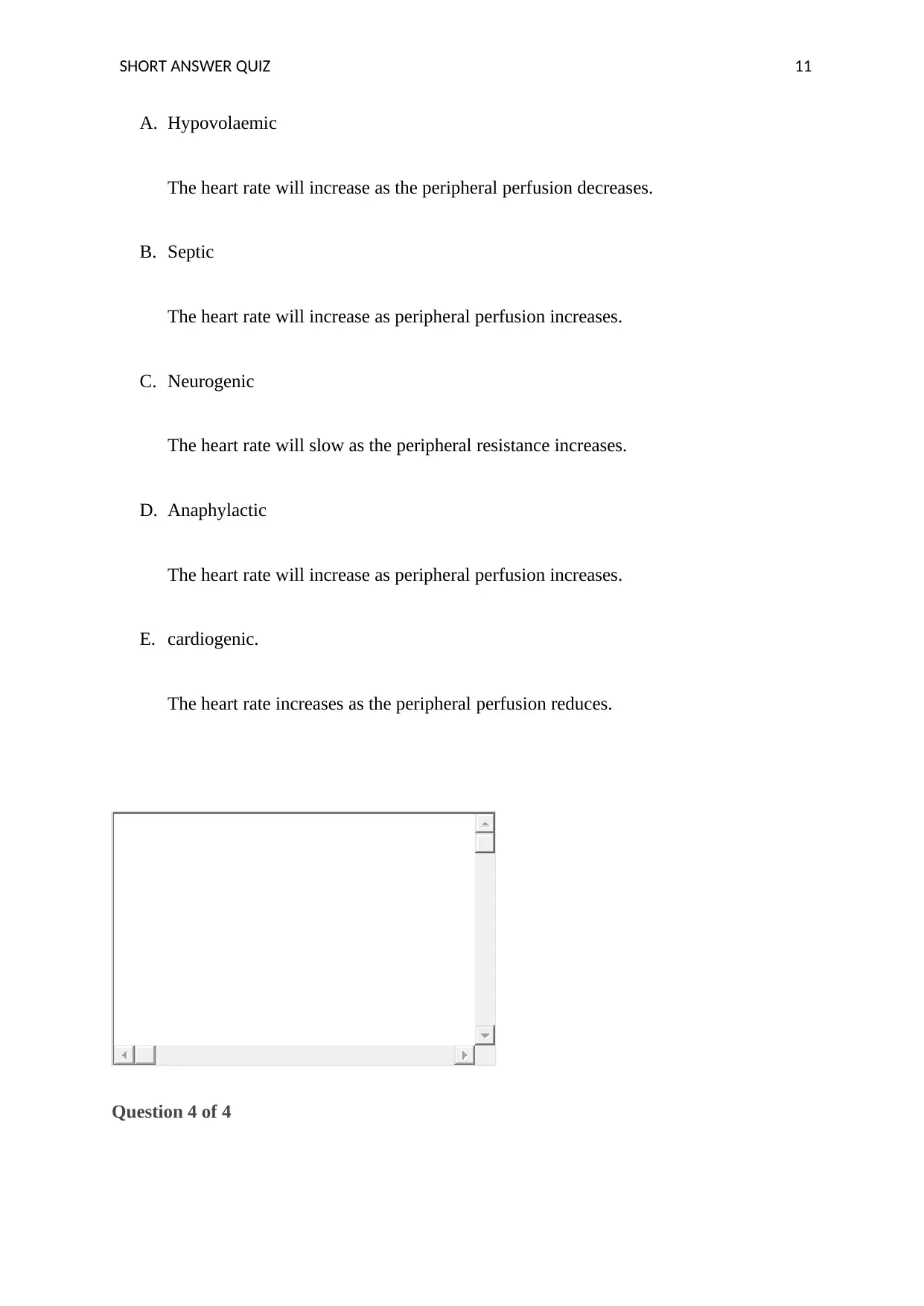
SHORT ANSWER QUIZ 11
A. Hypovolaemic
The heart rate will increase as the peripheral perfusion decreases.
B. Septic
The heart rate will increase as peripheral perfusion increases.
C. Neurogenic
The heart rate will slow as the peripheral resistance increases.
D. Anaphylactic
The heart rate will increase as peripheral perfusion increases.
E. cardiogenic.
The heart rate increases as the peripheral perfusion reduces.
Question 4 of 4
A. Hypovolaemic
The heart rate will increase as the peripheral perfusion decreases.
B. Septic
The heart rate will increase as peripheral perfusion increases.
C. Neurogenic
The heart rate will slow as the peripheral resistance increases.
D. Anaphylactic
The heart rate will increase as peripheral perfusion increases.
E. cardiogenic.
The heart rate increases as the peripheral perfusion reduces.
Question 4 of 4

SHORT ANSWER QUIZ 12
What mechanism initiates a systemic response to a reduction in blood pressure? Briefly
outline the main stages of the body’s response to a reduction in blood pressure and describe
potential masking agents.
The baroreceptor reflex is the principle negative feedback mechanism for blood
pressure control (Martini, Nath, & Bartholomew, 2015). The baroreceptors are located in the
arch of the aorta and the carotid sinus and they detect minor changes in blood pressure as
they are pressure sensitive (Waugh & Grant, 2010). They have neural connections to the
cardiovascular centers in the pons and medulla of the brainstem. The cardiovascular center
increases sympathetic nervous activity to the heart. This has the effect of increeasing the
heart rate and effectively increasing the stroke volume.
The cardiovascular center including the vasomotor center in the medulla also acts on
the blood vessels by increasing the sympathetic discharge to the vessels. The action of the
sympathetic nervous system on smooth muscles of the blood vessels is to cause
vasoconstriction (Martini, Nath, & Bartholomew, 2015). This increases the peripheral
resistance, the second factor in blood pressure control, which increases the blood pressure.
Potential masking occurs due to anxiety as neural mechanisms fail to adequately
control the pressure. This is because higher centres have inputs to the cardiovascular center.
Mosby'™s Paramedic Textbook 4th Edition
What mechanism initiates a systemic response to a reduction in blood pressure? Briefly
outline the main stages of the body’s response to a reduction in blood pressure and describe
potential masking agents.
The baroreceptor reflex is the principle negative feedback mechanism for blood
pressure control (Martini, Nath, & Bartholomew, 2015). The baroreceptors are located in the
arch of the aorta and the carotid sinus and they detect minor changes in blood pressure as
they are pressure sensitive (Waugh & Grant, 2010). They have neural connections to the
cardiovascular centers in the pons and medulla of the brainstem. The cardiovascular center
increases sympathetic nervous activity to the heart. This has the effect of increeasing the
heart rate and effectively increasing the stroke volume.
The cardiovascular center including the vasomotor center in the medulla also acts on
the blood vessels by increasing the sympathetic discharge to the vessels. The action of the
sympathetic nervous system on smooth muscles of the blood vessels is to cause
vasoconstriction (Martini, Nath, & Bartholomew, 2015). This increases the peripheral
resistance, the second factor in blood pressure control, which increases the blood pressure.
Potential masking occurs due to anxiety as neural mechanisms fail to adequately
control the pressure. This is because higher centres have inputs to the cardiovascular center.
Mosby'™s Paramedic Textbook 4th Edition
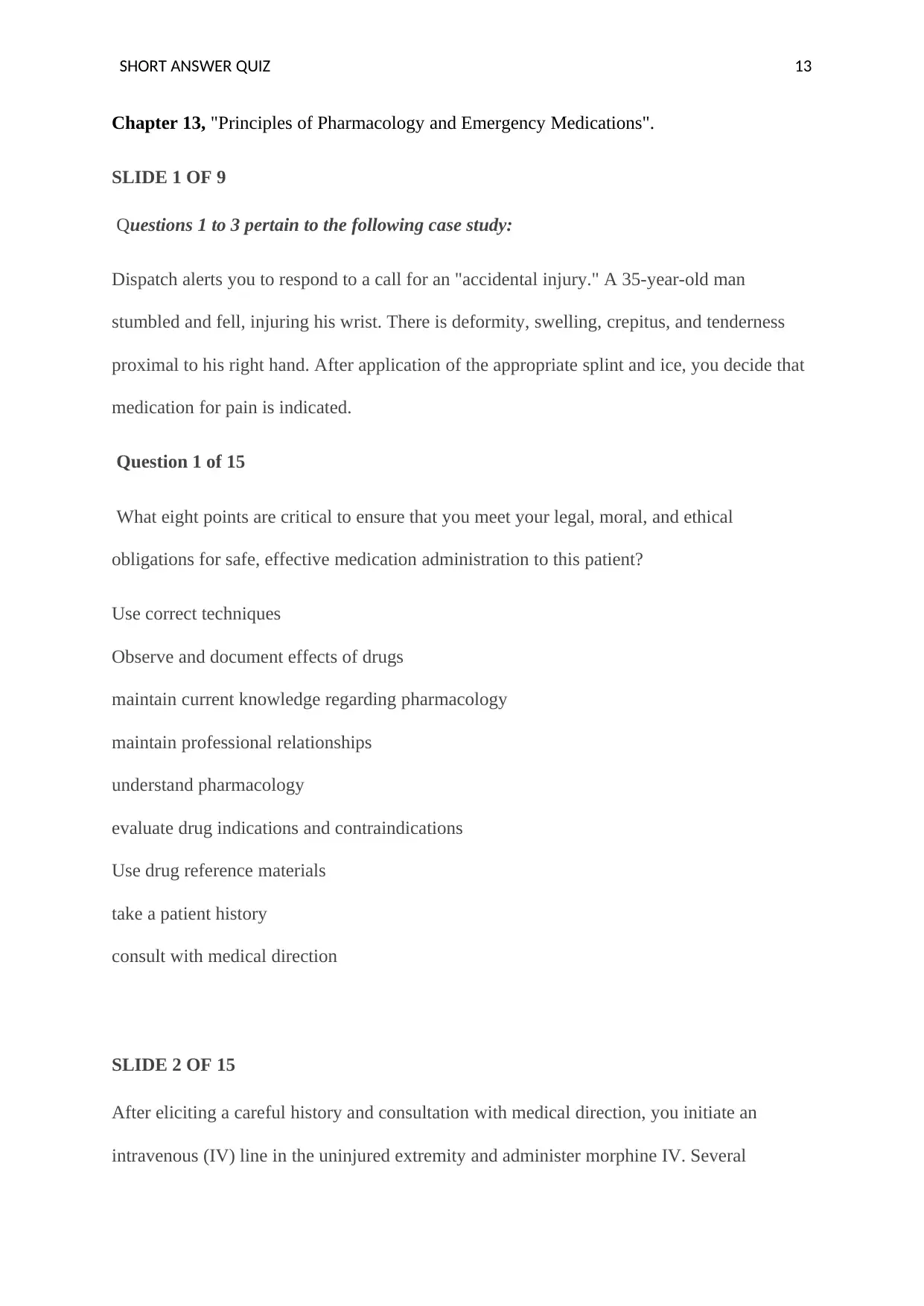
SHORT ANSWER QUIZ 13
Chapter 13, "Principles of Pharmacology and Emergency Medications".
SLIDE 1 OF 9
Questions 1 to 3 pertain to the following case study:
Dispatch alerts you to respond to a call for an "accidental injury." A 35-year-old man
stumbled and fell, injuring his wrist. There is deformity, swelling, crepitus, and tenderness
proximal to his right hand. After application of the appropriate splint and ice, you decide that
medication for pain is indicated.
Question 1 of 15
What eight points are critical to ensure that you meet your legal, moral, and ethical
obligations for safe, effective medication administration to this patient?
Use correct techniques
Observe and document effects of drugs
maintain current knowledge regarding pharmacology
maintain professional relationships
understand pharmacology
evaluate drug indications and contraindications
Use drug reference materials
take a patient history
consult with medical direction
SLIDE 2 OF 15
After eliciting a careful history and consultation with medical direction, you initiate an
intravenous (IV) line in the uninjured extremity and administer morphine IV. Several
Chapter 13, "Principles of Pharmacology and Emergency Medications".
SLIDE 1 OF 9
Questions 1 to 3 pertain to the following case study:
Dispatch alerts you to respond to a call for an "accidental injury." A 35-year-old man
stumbled and fell, injuring his wrist. There is deformity, swelling, crepitus, and tenderness
proximal to his right hand. After application of the appropriate splint and ice, you decide that
medication for pain is indicated.
Question 1 of 15
What eight points are critical to ensure that you meet your legal, moral, and ethical
obligations for safe, effective medication administration to this patient?
Use correct techniques
Observe and document effects of drugs
maintain current knowledge regarding pharmacology
maintain professional relationships
understand pharmacology
evaluate drug indications and contraindications
Use drug reference materials
take a patient history
consult with medical direction
SLIDE 2 OF 15
After eliciting a careful history and consultation with medical direction, you initiate an
intravenous (IV) line in the uninjured extremity and administer morphine IV. Several
Paraphrase This Document
Need a fresh take? Get an instant paraphrase of this document with our AI Paraphraser
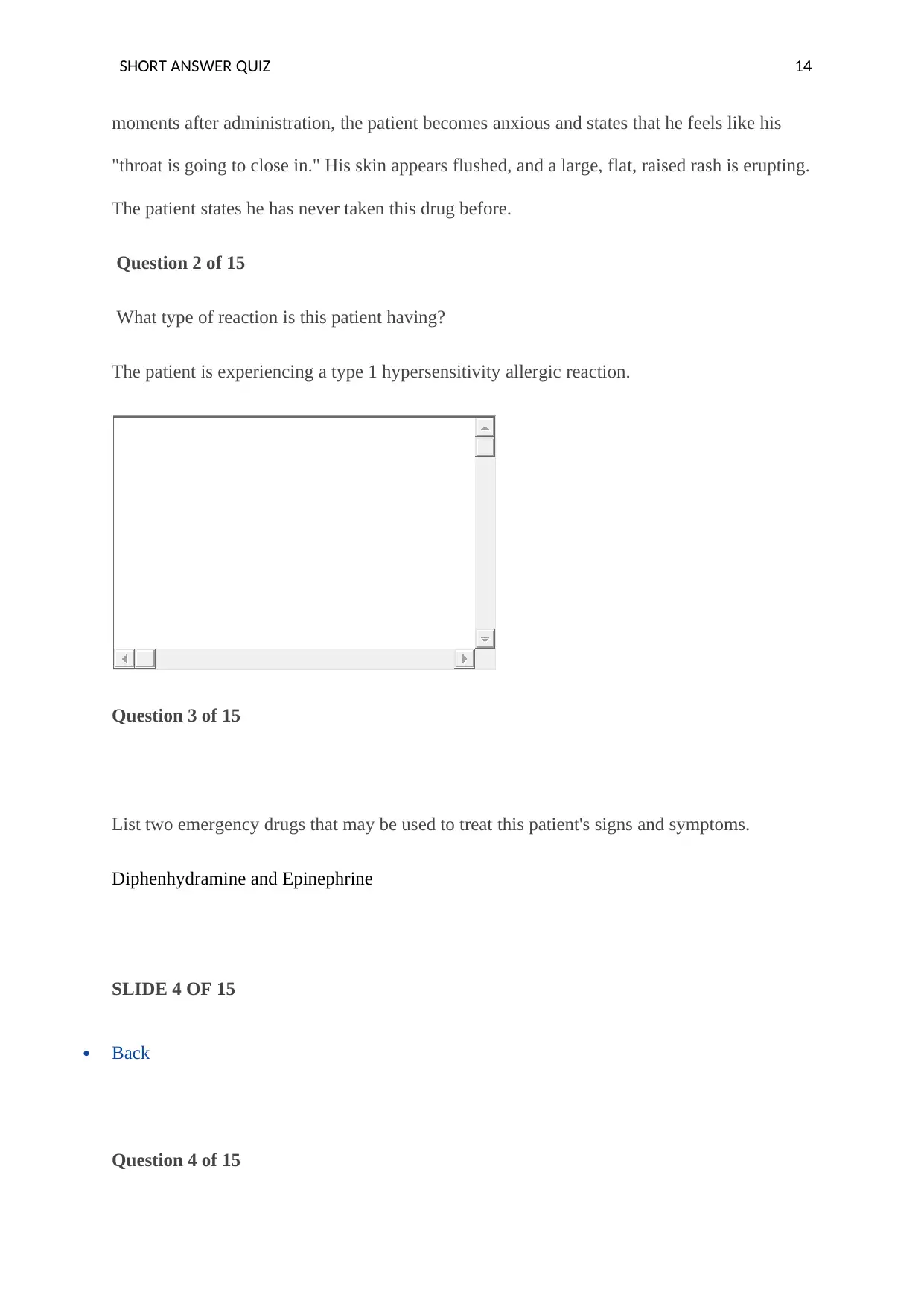
SHORT ANSWER QUIZ 14
moments after administration, the patient becomes anxious and states that he feels like his
"throat is going to close in." His skin appears flushed, and a large, flat, raised rash is erupting.
The patient states he has never taken this drug before.
Question 2 of 15
What type of reaction is this patient having?
The patient is experiencing a type 1 hypersensitivity allergic reaction.
Question 3 of 15
List two emergency drugs that may be used to treat this patient's signs and symptoms.
Diphenhydramine and Epinephrine
SLIDE 4 OF 15
Back
Question 4 of 15
moments after administration, the patient becomes anxious and states that he feels like his
"throat is going to close in." His skin appears flushed, and a large, flat, raised rash is erupting.
The patient states he has never taken this drug before.
Question 2 of 15
What type of reaction is this patient having?
The patient is experiencing a type 1 hypersensitivity allergic reaction.
Question 3 of 15
List two emergency drugs that may be used to treat this patient's signs and symptoms.
Diphenhydramine and Epinephrine
SLIDE 4 OF 15
Back
Question 4 of 15
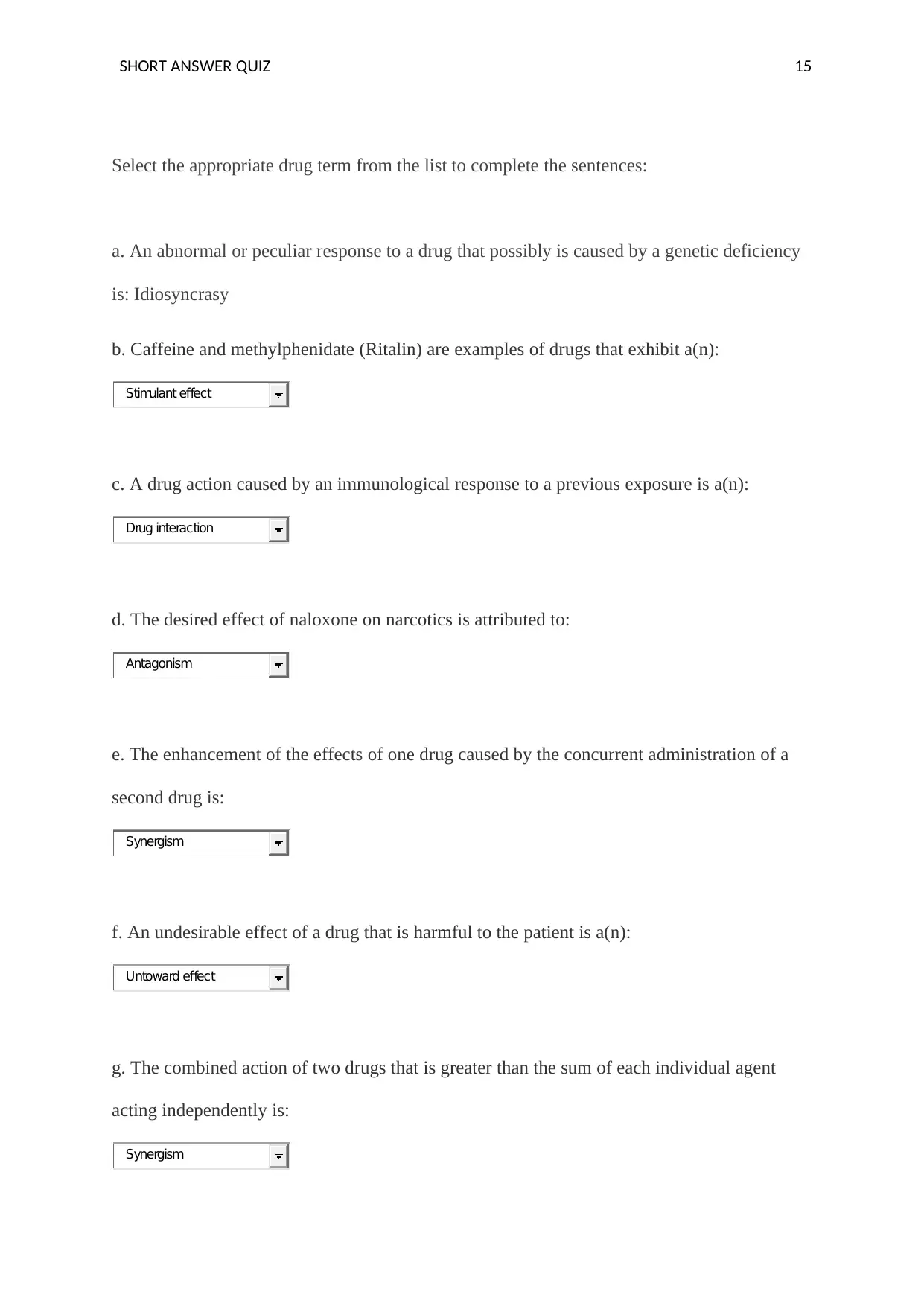
SHORT ANSWER QUIZ 15
Select the appropriate drug term from the list to complete the sentences:
a. An abnormal or peculiar response to a drug that possibly is caused by a genetic deficiency
is: Idiosyncrasy
b. Caffeine and methylphenidate (Ritalin) are examples of drugs that exhibit a(n):
c. A drug action caused by an immunological response to a previous exposure is a(n):
d. The desired effect of naloxone on narcotics is attributed to:
e. The enhancement of the effects of one drug caused by the concurrent administration of a
second drug is:
f. An undesirable effect of a drug that is harmful to the patient is a(n):
g. The combined action of two drugs that is greater than the sum of each individual agent
acting independently is:
Stimulant effect
Drug interaction
Antagonism
Synergism
Untoward effect
Synergism
Select the appropriate drug term from the list to complete the sentences:
a. An abnormal or peculiar response to a drug that possibly is caused by a genetic deficiency
is: Idiosyncrasy
b. Caffeine and methylphenidate (Ritalin) are examples of drugs that exhibit a(n):
c. A drug action caused by an immunological response to a previous exposure is a(n):
d. The desired effect of naloxone on narcotics is attributed to:
e. The enhancement of the effects of one drug caused by the concurrent administration of a
second drug is:
f. An undesirable effect of a drug that is harmful to the patient is a(n):
g. The combined action of two drugs that is greater than the sum of each individual agent
acting independently is:
Stimulant effect
Drug interaction
Antagonism
Synergism
Untoward effect
Synergism
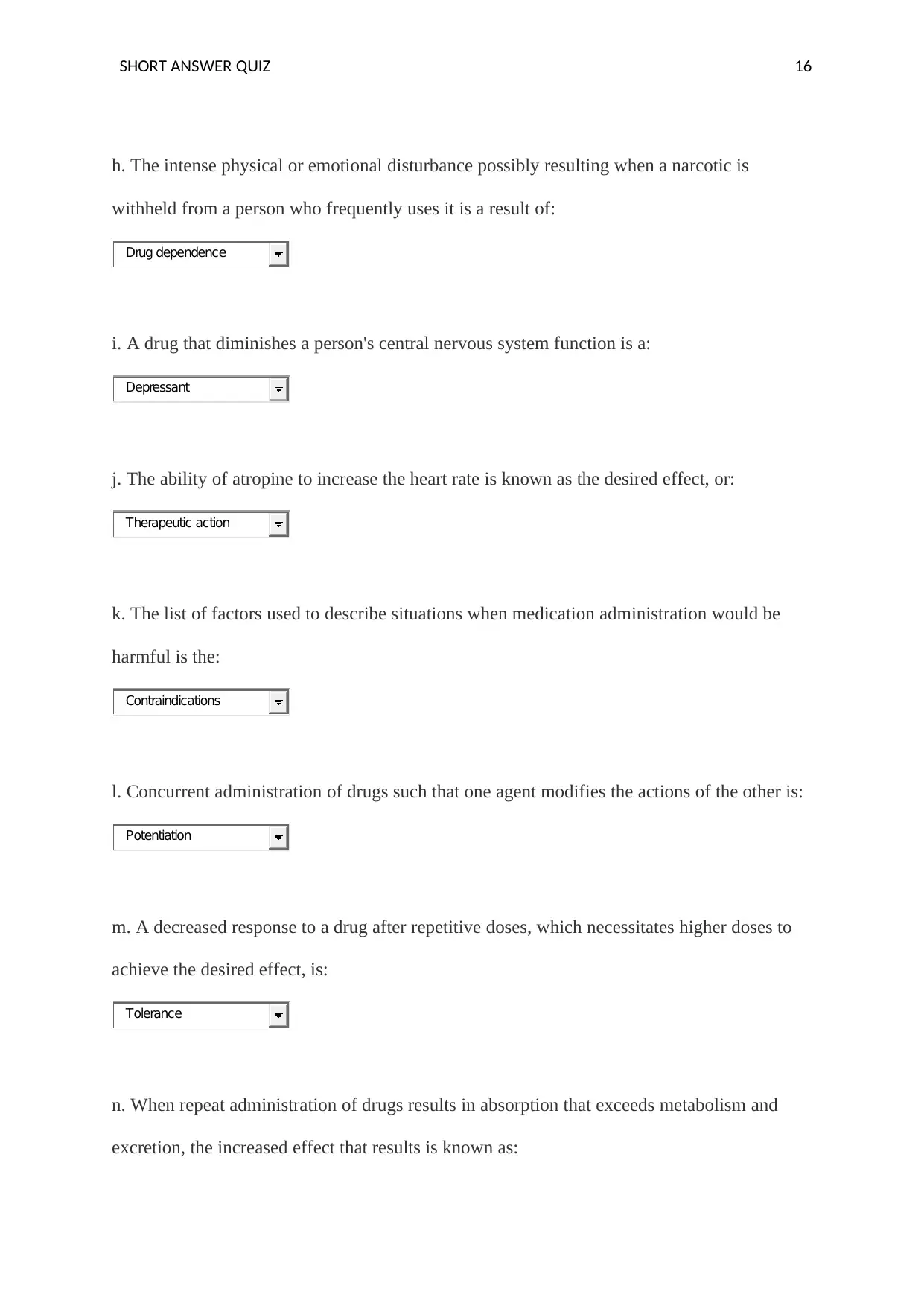
SHORT ANSWER QUIZ 16
h. The intense physical or emotional disturbance possibly resulting when a narcotic is
withheld from a person who frequently uses it is a result of:
i. A drug that diminishes a person's central nervous system function is a:
j. The ability of atropine to increase the heart rate is known as the desired effect, or:
k. The list of factors used to describe situations when medication administration would be
harmful is the:
l. Concurrent administration of drugs such that one agent modifies the actions of the other is:
m. A decreased response to a drug after repetitive doses, which necessitates higher doses to
achieve the desired effect, is:
n. When repeat administration of drugs results in absorption that exceeds metabolism and
excretion, the increased effect that results is known as:
Drug dependence
Depressant
Therapeutic action
Contraindications
Potentiation
Tolerance
h. The intense physical or emotional disturbance possibly resulting when a narcotic is
withheld from a person who frequently uses it is a result of:
i. A drug that diminishes a person's central nervous system function is a:
j. The ability of atropine to increase the heart rate is known as the desired effect, or:
k. The list of factors used to describe situations when medication administration would be
harmful is the:
l. Concurrent administration of drugs such that one agent modifies the actions of the other is:
m. A decreased response to a drug after repetitive doses, which necessitates higher doses to
achieve the desired effect, is:
n. When repeat administration of drugs results in absorption that exceeds metabolism and
excretion, the increased effect that results is known as:
Drug dependence
Depressant
Therapeutic action
Contraindications
Potentiation
Tolerance
Secure Best Marks with AI Grader
Need help grading? Try our AI Grader for instant feedback on your assignments.
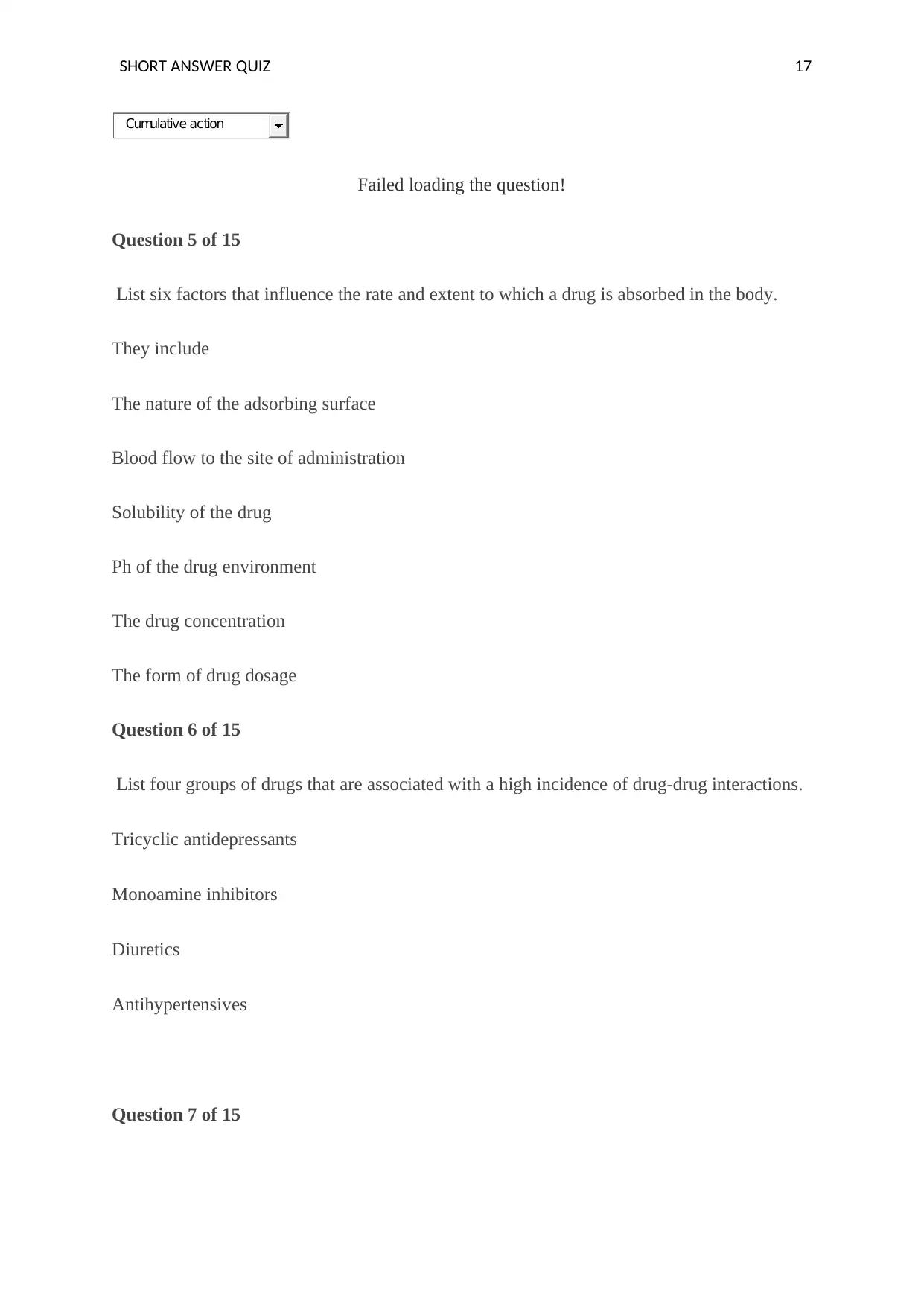
SHORT ANSWER QUIZ 17
Failed loading the question!
Question 5 of 15
List six factors that influence the rate and extent to which a drug is absorbed in the body.
They include
The nature of the adsorbing surface
Blood flow to the site of administration
Solubility of the drug
Ph of the drug environment
The drug concentration
The form of drug dosage
Question 6 of 15
List four groups of drugs that are associated with a high incidence of drug-drug interactions.
Tricyclic antidepressants
Monoamine inhibitors
Diuretics
Antihypertensives
Question 7 of 15
Cumulative action
Failed loading the question!
Question 5 of 15
List six factors that influence the rate and extent to which a drug is absorbed in the body.
They include
The nature of the adsorbing surface
Blood flow to the site of administration
Solubility of the drug
Ph of the drug environment
The drug concentration
The form of drug dosage
Question 6 of 15
List four groups of drugs that are associated with a high incidence of drug-drug interactions.
Tricyclic antidepressants
Monoamine inhibitors
Diuretics
Antihypertensives
Question 7 of 15
Cumulative action
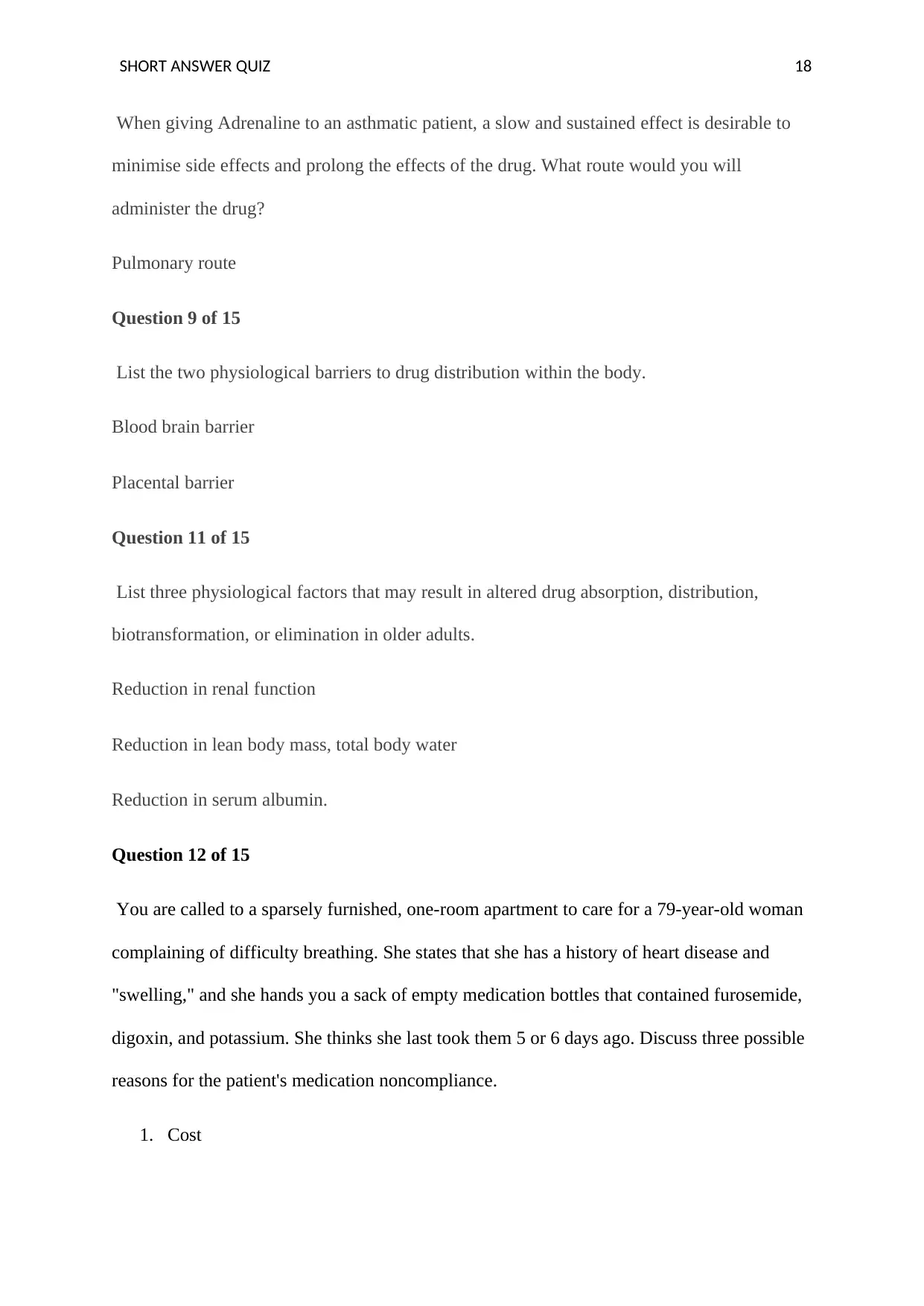
SHORT ANSWER QUIZ 18
When giving Adrenaline to an asthmatic patient, a slow and sustained effect is desirable to
minimise side effects and prolong the effects of the drug. What route would you will
administer the drug?
Pulmonary route
Question 9 of 15
List the two physiological barriers to drug distribution within the body.
Blood brain barrier
Placental barrier
Question 11 of 15
List three physiological factors that may result in altered drug absorption, distribution,
biotransformation, or elimination in older adults.
Reduction in renal function
Reduction in lean body mass, total body water
Reduction in serum albumin.
Question 12 of 15
You are called to a sparsely furnished, one-room apartment to care for a 79-year-old woman
complaining of difficulty breathing. She states that she has a history of heart disease and
"swelling," and she hands you a sack of empty medication bottles that contained furosemide,
digoxin, and potassium. She thinks she last took them 5 or 6 days ago. Discuss three possible
reasons for the patient's medication noncompliance.
1. Cost
When giving Adrenaline to an asthmatic patient, a slow and sustained effect is desirable to
minimise side effects and prolong the effects of the drug. What route would you will
administer the drug?
Pulmonary route
Question 9 of 15
List the two physiological barriers to drug distribution within the body.
Blood brain barrier
Placental barrier
Question 11 of 15
List three physiological factors that may result in altered drug absorption, distribution,
biotransformation, or elimination in older adults.
Reduction in renal function
Reduction in lean body mass, total body water
Reduction in serum albumin.
Question 12 of 15
You are called to a sparsely furnished, one-room apartment to care for a 79-year-old woman
complaining of difficulty breathing. She states that she has a history of heart disease and
"swelling," and she hands you a sack of empty medication bottles that contained furosemide,
digoxin, and potassium. She thinks she last took them 5 or 6 days ago. Discuss three possible
reasons for the patient's medication noncompliance.
1. Cost
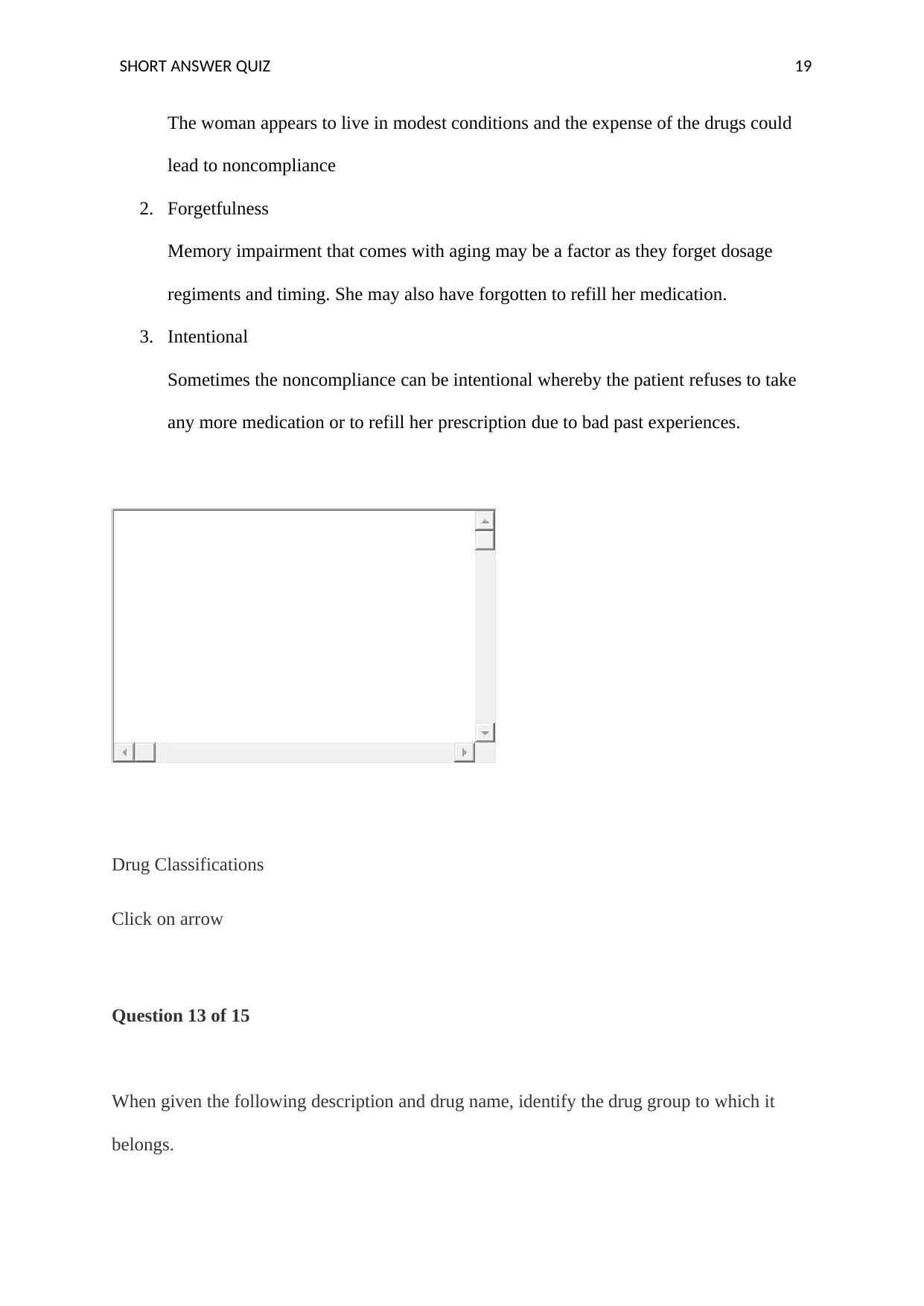
SHORT ANSWER QUIZ 19
The woman appears to live in modest conditions and the expense of the drugs could
lead to noncompliance
2. Forgetfulness
Memory impairment that comes with aging may be a factor as they forget dosage
regiments and timing. She may also have forgotten to refill her medication.
3. Intentional
Sometimes the noncompliance can be intentional whereby the patient refuses to take
any more medication or to refill her prescription due to bad past experiences.
Drug Classifications
Click on arrow
Question 13 of 15
When given the following description and drug name, identify the drug group to which it
belongs.
The woman appears to live in modest conditions and the expense of the drugs could
lead to noncompliance
2. Forgetfulness
Memory impairment that comes with aging may be a factor as they forget dosage
regiments and timing. She may also have forgotten to refill her medication.
3. Intentional
Sometimes the noncompliance can be intentional whereby the patient refuses to take
any more medication or to refill her prescription due to bad past experiences.
Drug Classifications
Click on arrow
Question 13 of 15
When given the following description and drug name, identify the drug group to which it
belongs.
Paraphrase This Document
Need a fresh take? Get an instant paraphrase of this document with our AI Paraphraser
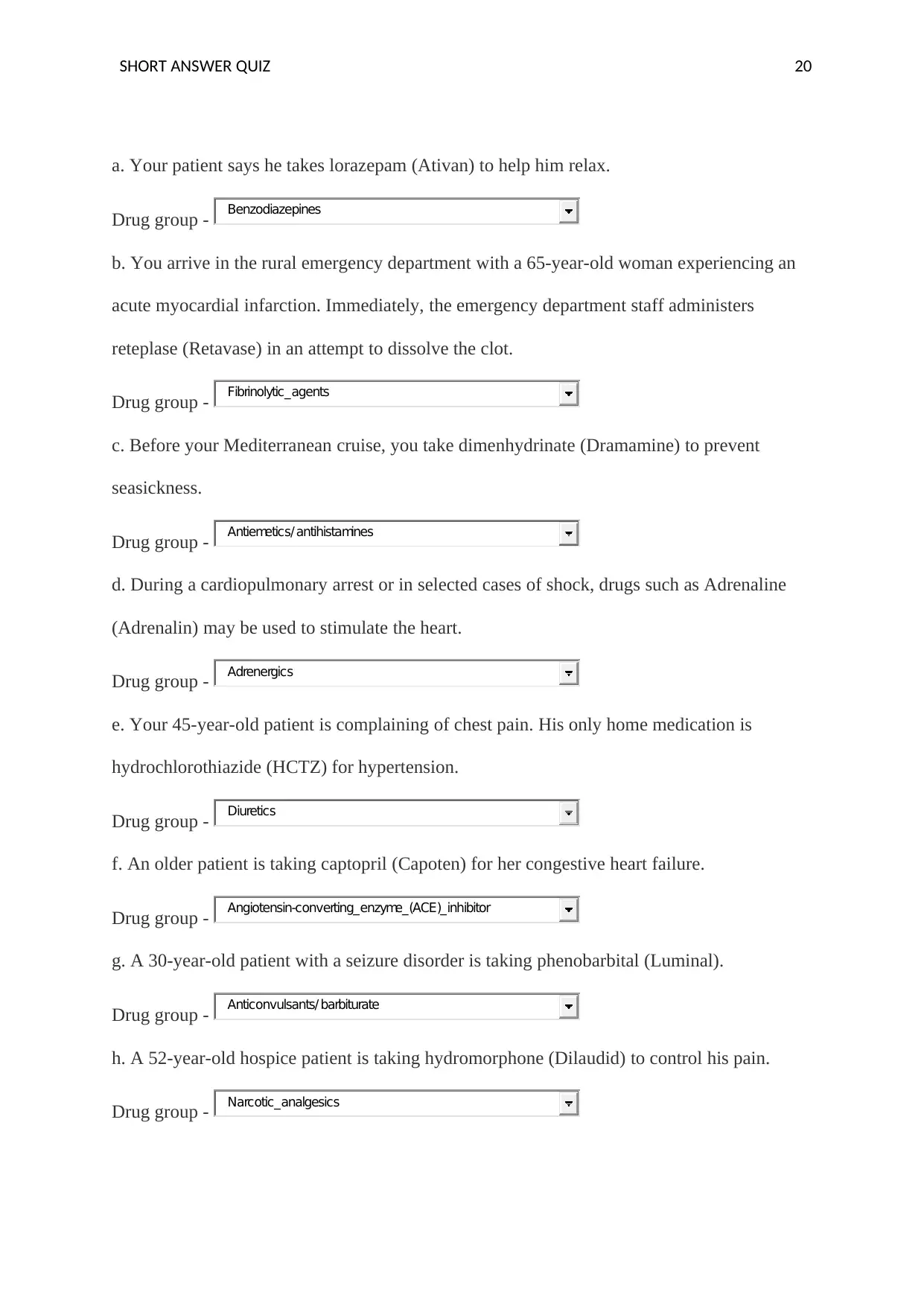
SHORT ANSWER QUIZ 20
a. Your patient says he takes lorazepam (Ativan) to help him relax.
Drug group -
b. You arrive in the rural emergency department with a 65-year-old woman experiencing an
acute myocardial infarction. Immediately, the emergency department staff administers
reteplase (Retavase) in an attempt to dissolve the clot.
Drug group -
c. Before your Mediterranean cruise, you take dimenhydrinate (Dramamine) to prevent
seasickness.
Drug group -
d. During a cardiopulmonary arrest or in selected cases of shock, drugs such as Adrenaline
(Adrenalin) may be used to stimulate the heart.
Drug group -
e. Your 45-year-old patient is complaining of chest pain. His only home medication is
hydrochlorothiazide (HCTZ) for hypertension.
Drug group -
f. An older patient is taking captopril (Capoten) for her congestive heart failure.
Drug group -
g. A 30-year-old patient with a seizure disorder is taking phenobarbital (Luminal).
Drug group -
h. A 52-year-old hospice patient is taking hydromorphone (Dilaudid) to control his pain.
Drug group -
Benzodiazepines
Fibrinolytic_agents
Antiemetics/ antihistamines
Adrenergics
Diuretics
Angiotensin-converting_enzyme_(ACE)_inhibitor
Anticonvulsants/ barbiturate
Narcotic_analgesics
a. Your patient says he takes lorazepam (Ativan) to help him relax.
Drug group -
b. You arrive in the rural emergency department with a 65-year-old woman experiencing an
acute myocardial infarction. Immediately, the emergency department staff administers
reteplase (Retavase) in an attempt to dissolve the clot.
Drug group -
c. Before your Mediterranean cruise, you take dimenhydrinate (Dramamine) to prevent
seasickness.
Drug group -
d. During a cardiopulmonary arrest or in selected cases of shock, drugs such as Adrenaline
(Adrenalin) may be used to stimulate the heart.
Drug group -
e. Your 45-year-old patient is complaining of chest pain. His only home medication is
hydrochlorothiazide (HCTZ) for hypertension.
Drug group -
f. An older patient is taking captopril (Capoten) for her congestive heart failure.
Drug group -
g. A 30-year-old patient with a seizure disorder is taking phenobarbital (Luminal).
Drug group -
h. A 52-year-old hospice patient is taking hydromorphone (Dilaudid) to control his pain.
Drug group -
Benzodiazepines
Fibrinolytic_agents
Antiemetics/ antihistamines
Adrenergics
Diuretics
Angiotensin-converting_enzyme_(ACE)_inhibitor
Anticonvulsants/ barbiturate
Narcotic_analgesics
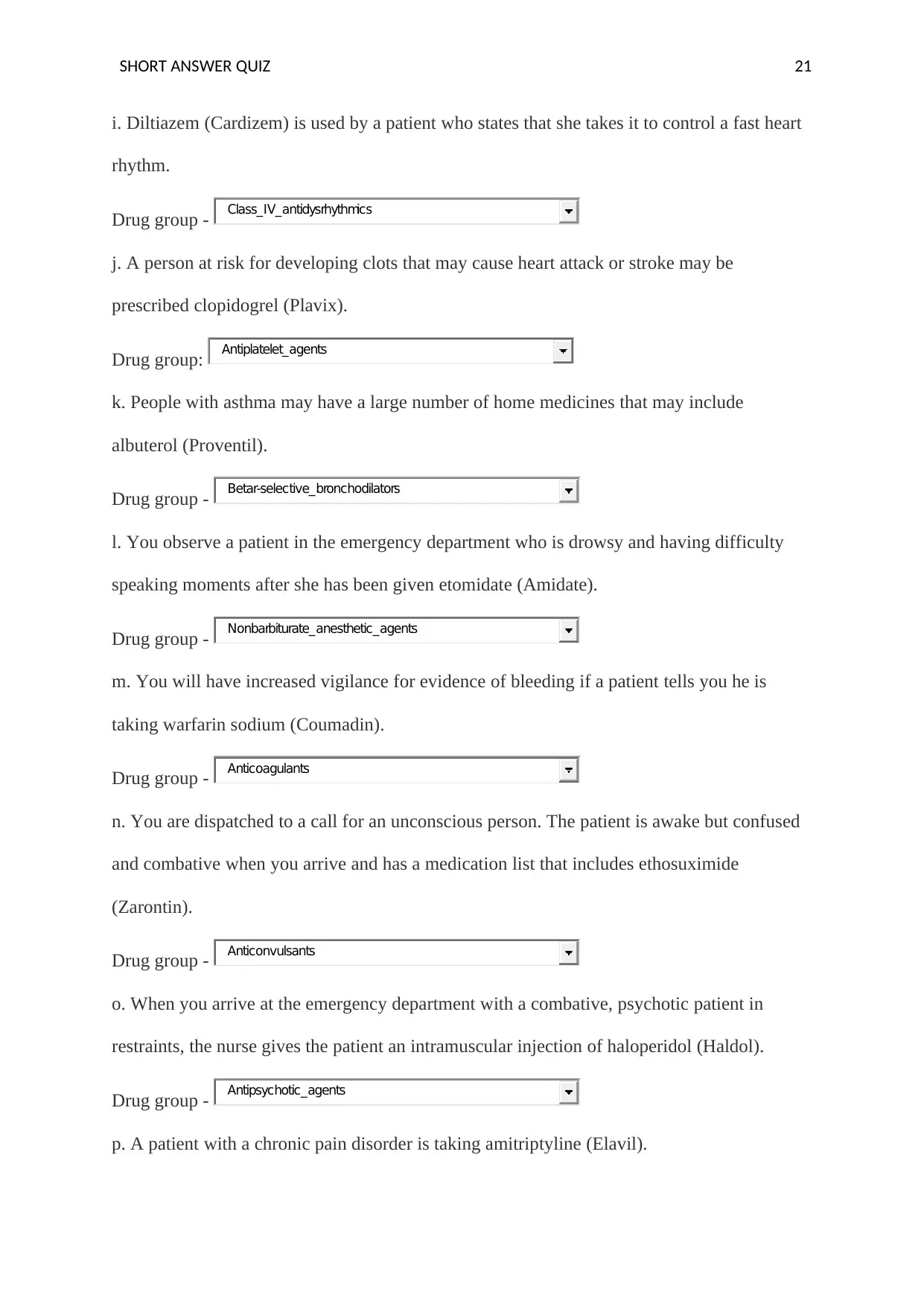
SHORT ANSWER QUIZ 21
i. Diltiazem (Cardizem) is used by a patient who states that she takes it to control a fast heart
rhythm.
Drug group -
j. A person at risk for developing clots that may cause heart attack or stroke may be
prescribed clopidogrel (Plavix).
Drug group:
k. People with asthma may have a large number of home medicines that may include
albuterol (Proventil).
Drug group -
l. You observe a patient in the emergency department who is drowsy and having difficulty
speaking moments after she has been given etomidate (Amidate).
Drug group -
m. You will have increased vigilance for evidence of bleeding if a patient tells you he is
taking warfarin sodium (Coumadin).
Drug group -
n. You are dispatched to a call for an unconscious person. The patient is awake but confused
and combative when you arrive and has a medication list that includes ethosuximide
(Zarontin).
Drug group -
o. When you arrive at the emergency department with a combative, psychotic patient in
restraints, the nurse gives the patient an intramuscular injection of haloperidol (Haldol).
Drug group -
p. A patient with a chronic pain disorder is taking amitriptyline (Elavil).
Class_IV_antidysrhythmics
Antiplatelet_agents
Betar-selective_bronchodilators
Nonbarbiturate_anesthetic_agents
Anticoagulants
Anticonvulsants
Antipsychotic_agents
i. Diltiazem (Cardizem) is used by a patient who states that she takes it to control a fast heart
rhythm.
Drug group -
j. A person at risk for developing clots that may cause heart attack or stroke may be
prescribed clopidogrel (Plavix).
Drug group:
k. People with asthma may have a large number of home medicines that may include
albuterol (Proventil).
Drug group -
l. You observe a patient in the emergency department who is drowsy and having difficulty
speaking moments after she has been given etomidate (Amidate).
Drug group -
m. You will have increased vigilance for evidence of bleeding if a patient tells you he is
taking warfarin sodium (Coumadin).
Drug group -
n. You are dispatched to a call for an unconscious person. The patient is awake but confused
and combative when you arrive and has a medication list that includes ethosuximide
(Zarontin).
Drug group -
o. When you arrive at the emergency department with a combative, psychotic patient in
restraints, the nurse gives the patient an intramuscular injection of haloperidol (Haldol).
Drug group -
p. A patient with a chronic pain disorder is taking amitriptyline (Elavil).
Class_IV_antidysrhythmics
Antiplatelet_agents
Betar-selective_bronchodilators
Nonbarbiturate_anesthetic_agents
Anticoagulants
Anticonvulsants
Antipsychotic_agents
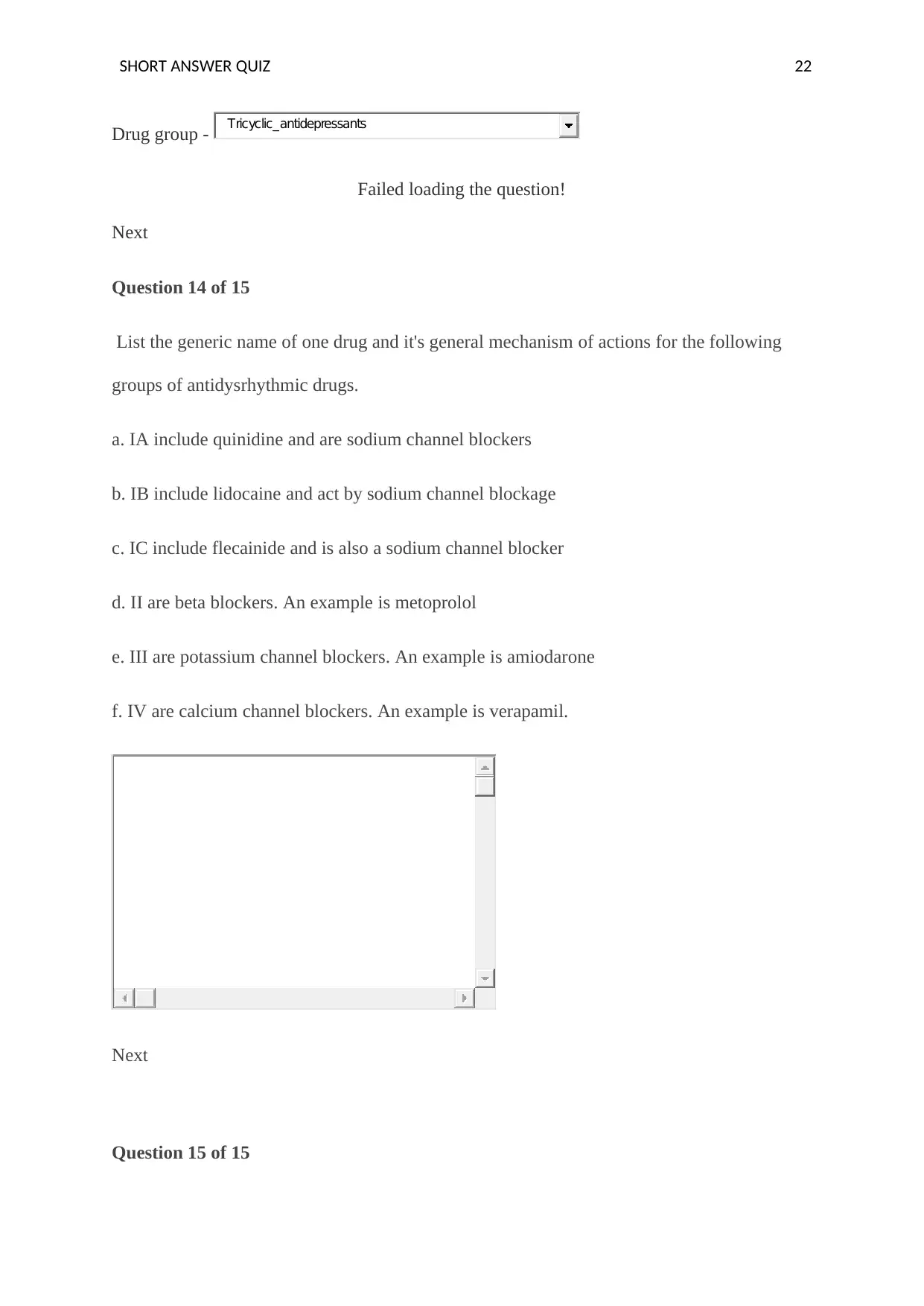
SHORT ANSWER QUIZ 22
Drug group -
Failed loading the question!
Next
Question 14 of 15
List the generic name of one drug and it's general mechanism of actions for the following
groups of antidysrhythmic drugs.
a. IA include quinidine and are sodium channel blockers
b. IB include lidocaine and act by sodium channel blockage
c. IC include flecainide and is also a sodium channel blocker
d. II are beta blockers. An example is metoprolol
e. III are potassium channel blockers. An example is amiodarone
f. IV are calcium channel blockers. An example is verapamil.
Next
Question 15 of 15
Tricyclic_antidepressants
Drug group -
Failed loading the question!
Next
Question 14 of 15
List the generic name of one drug and it's general mechanism of actions for the following
groups of antidysrhythmic drugs.
a. IA include quinidine and are sodium channel blockers
b. IB include lidocaine and act by sodium channel blockage
c. IC include flecainide and is also a sodium channel blocker
d. II are beta blockers. An example is metoprolol
e. III are potassium channel blockers. An example is amiodarone
f. IV are calcium channel blockers. An example is verapamil.
Next
Question 15 of 15
Tricyclic_antidepressants
Secure Best Marks with AI Grader
Need help grading? Try our AI Grader for instant feedback on your assignments.
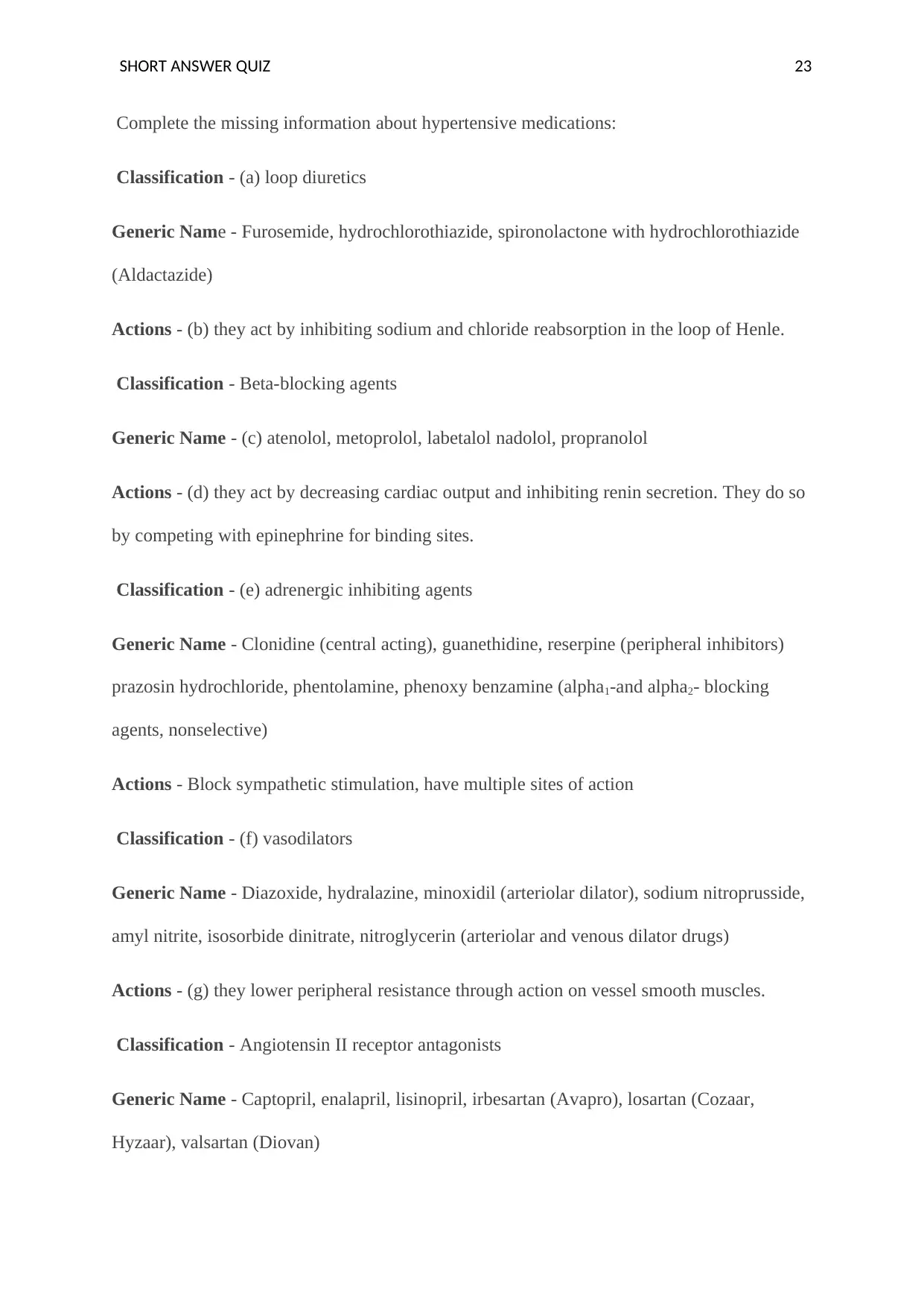
SHORT ANSWER QUIZ 23
Complete the missing information about hypertensive medications:
Classification - (a) loop diuretics
Generic Name - Furosemide, hydrochlorothiazide, spironolactone with hydrochlorothiazide
(Aldactazide)
Actions - (b) they act by inhibiting sodium and chloride reabsorption in the loop of Henle.
Classification - Beta-blocking agents
Generic Name - (c) atenolol, metoprolol, labetalol nadolol, propranolol
Actions - (d) they act by decreasing cardiac output and inhibiting renin secretion. They do so
by competing with epinephrine for binding sites.
Classification - (e) adrenergic inhibiting agents
Generic Name - Clonidine (central acting), guanethidine, reserpine (peripheral inhibitors)
prazosin hydrochloride, phentolamine, phenoxy benzamine (alpha1-and alpha2- blocking
agents, nonselective)
Actions - Block sympathetic stimulation, have multiple sites of action
Classification - (f) vasodilators
Generic Name - Diazoxide, hydralazine, minoxidil (arteriolar dilator), sodium nitroprusside,
amyl nitrite, isosorbide dinitrate, nitroglycerin (arteriolar and venous dilator drugs)
Actions - (g) they lower peripheral resistance through action on vessel smooth muscles.
Classification - Angiotensin II receptor antagonists
Generic Name - Captopril, enalapril, lisinopril, irbesartan (Avapro), losartan (Cozaar,
Hyzaar), valsartan (Diovan)
Complete the missing information about hypertensive medications:
Classification - (a) loop diuretics
Generic Name - Furosemide, hydrochlorothiazide, spironolactone with hydrochlorothiazide
(Aldactazide)
Actions - (b) they act by inhibiting sodium and chloride reabsorption in the loop of Henle.
Classification - Beta-blocking agents
Generic Name - (c) atenolol, metoprolol, labetalol nadolol, propranolol
Actions - (d) they act by decreasing cardiac output and inhibiting renin secretion. They do so
by competing with epinephrine for binding sites.
Classification - (e) adrenergic inhibiting agents
Generic Name - Clonidine (central acting), guanethidine, reserpine (peripheral inhibitors)
prazosin hydrochloride, phentolamine, phenoxy benzamine (alpha1-and alpha2- blocking
agents, nonselective)
Actions - Block sympathetic stimulation, have multiple sites of action
Classification - (f) vasodilators
Generic Name - Diazoxide, hydralazine, minoxidil (arteriolar dilator), sodium nitroprusside,
amyl nitrite, isosorbide dinitrate, nitroglycerin (arteriolar and venous dilator drugs)
Actions - (g) they lower peripheral resistance through action on vessel smooth muscles.
Classification - Angiotensin II receptor antagonists
Generic Name - Captopril, enalapril, lisinopril, irbesartan (Avapro), losartan (Cozaar,
Hyzaar), valsartan (Diovan)
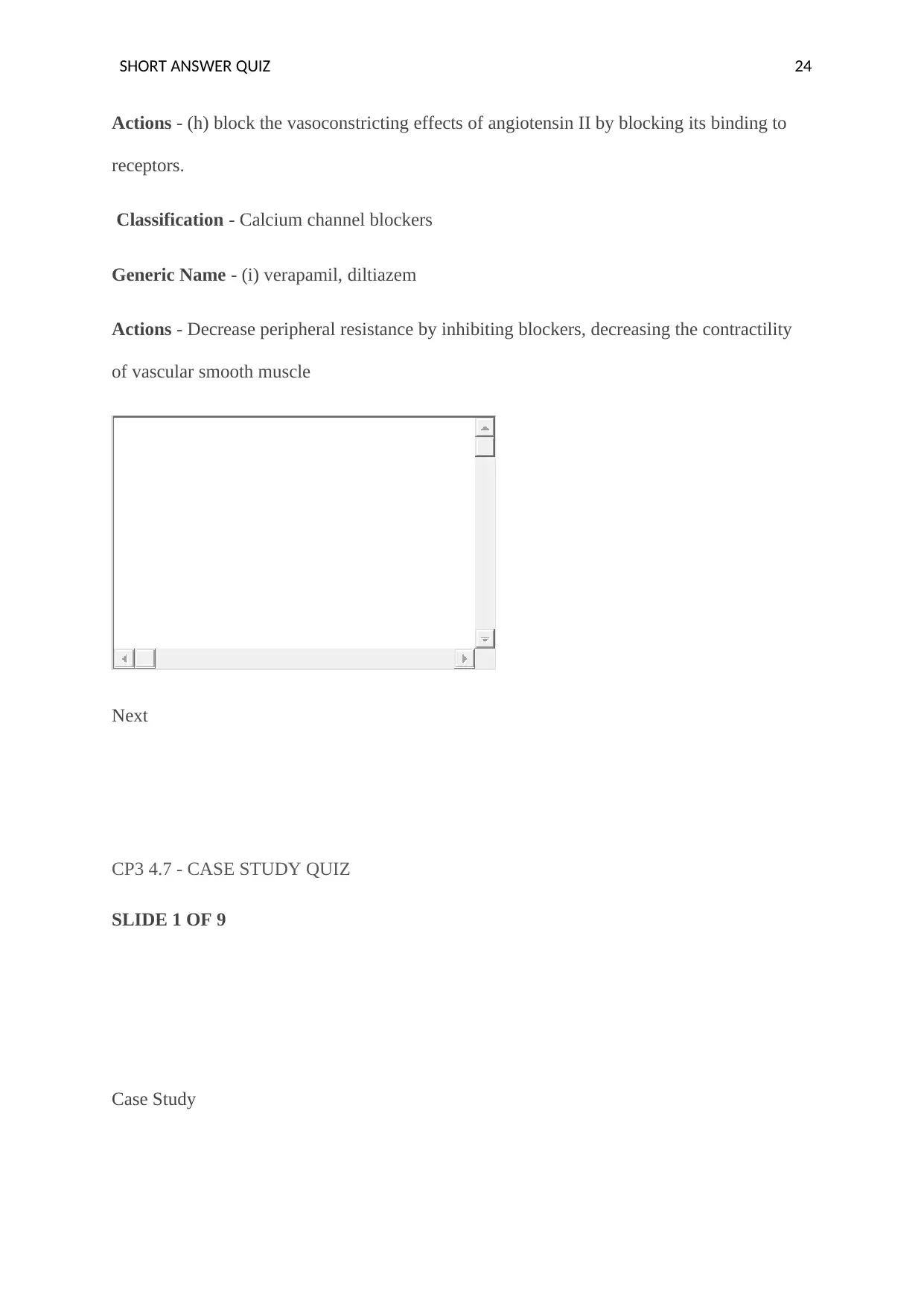
SHORT ANSWER QUIZ 24
Actions - (h) block the vasoconstricting effects of angiotensin II by blocking its binding to
receptors.
Classification - Calcium channel blockers
Generic Name - (i) verapamil, diltiazem
Actions - Decrease peripheral resistance by inhibiting blockers, decreasing the contractility
of vascular smooth muscle
Next
CP3 4.7 - CASE STUDY QUIZ
SLIDE 1 OF 9
Case Study
Actions - (h) block the vasoconstricting effects of angiotensin II by blocking its binding to
receptors.
Classification - Calcium channel blockers
Generic Name - (i) verapamil, diltiazem
Actions - Decrease peripheral resistance by inhibiting blockers, decreasing the contractility
of vascular smooth muscle
Next
CP3 4.7 - CASE STUDY QUIZ
SLIDE 1 OF 9
Case Study
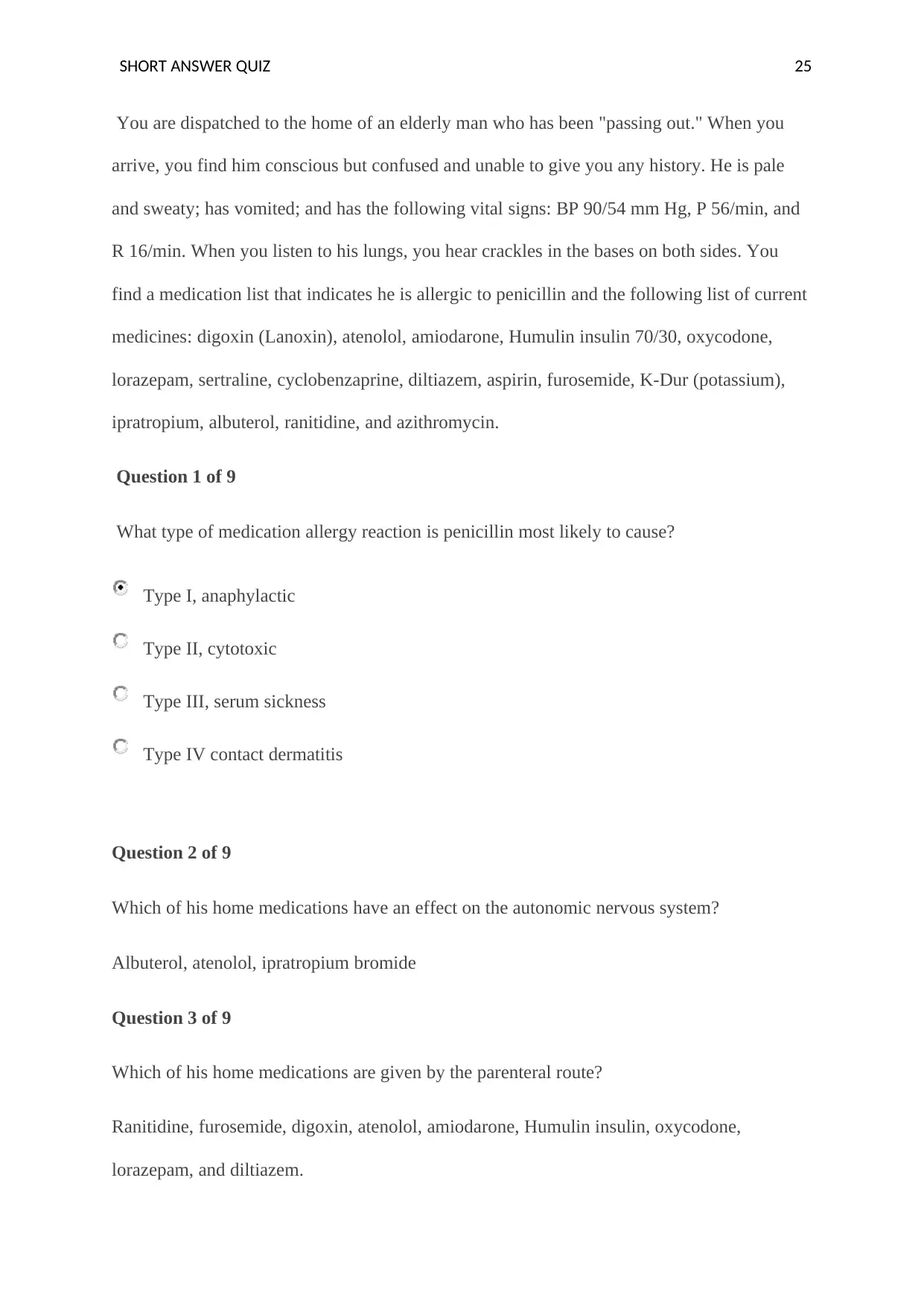
SHORT ANSWER QUIZ 25
You are dispatched to the home of an elderly man who has been "passing out." When you
arrive, you find him conscious but confused and unable to give you any history. He is pale
and sweaty; has vomited; and has the following vital signs: BP 90/54 mm Hg, P 56/min, and
R 16/min. When you listen to his lungs, you hear crackles in the bases on both sides. You
find a medication list that indicates he is allergic to penicillin and the following list of current
medicines: digoxin (Lanoxin), atenolol, amiodarone, Humulin insulin 70/30, oxycodone,
lorazepam, sertraline, cyclobenzaprine, diltiazem, aspirin, furosemide, K-Dur (potassium),
ipratropium, albuterol, ranitidine, and azithromycin.
Question 1 of 9
What type of medication allergy reaction is penicillin most likely to cause?
Type I, anaphylactic
Type II, cytotoxic
Type III, serum sickness
Type IV contact dermatitis
Question 2 of 9
Which of his home medications have an effect on the autonomic nervous system?
Albuterol, atenolol, ipratropium bromide
Question 3 of 9
Which of his home medications are given by the parenteral route?
Ranitidine, furosemide, digoxin, atenolol, amiodarone, Humulin insulin, oxycodone,
lorazepam, and diltiazem.
You are dispatched to the home of an elderly man who has been "passing out." When you
arrive, you find him conscious but confused and unable to give you any history. He is pale
and sweaty; has vomited; and has the following vital signs: BP 90/54 mm Hg, P 56/min, and
R 16/min. When you listen to his lungs, you hear crackles in the bases on both sides. You
find a medication list that indicates he is allergic to penicillin and the following list of current
medicines: digoxin (Lanoxin), atenolol, amiodarone, Humulin insulin 70/30, oxycodone,
lorazepam, sertraline, cyclobenzaprine, diltiazem, aspirin, furosemide, K-Dur (potassium),
ipratropium, albuterol, ranitidine, and azithromycin.
Question 1 of 9
What type of medication allergy reaction is penicillin most likely to cause?
Type I, anaphylactic
Type II, cytotoxic
Type III, serum sickness
Type IV contact dermatitis
Question 2 of 9
Which of his home medications have an effect on the autonomic nervous system?
Albuterol, atenolol, ipratropium bromide
Question 3 of 9
Which of his home medications are given by the parenteral route?
Ranitidine, furosemide, digoxin, atenolol, amiodarone, Humulin insulin, oxycodone,
lorazepam, and diltiazem.
Paraphrase This Document
Need a fresh take? Get an instant paraphrase of this document with our AI Paraphraser
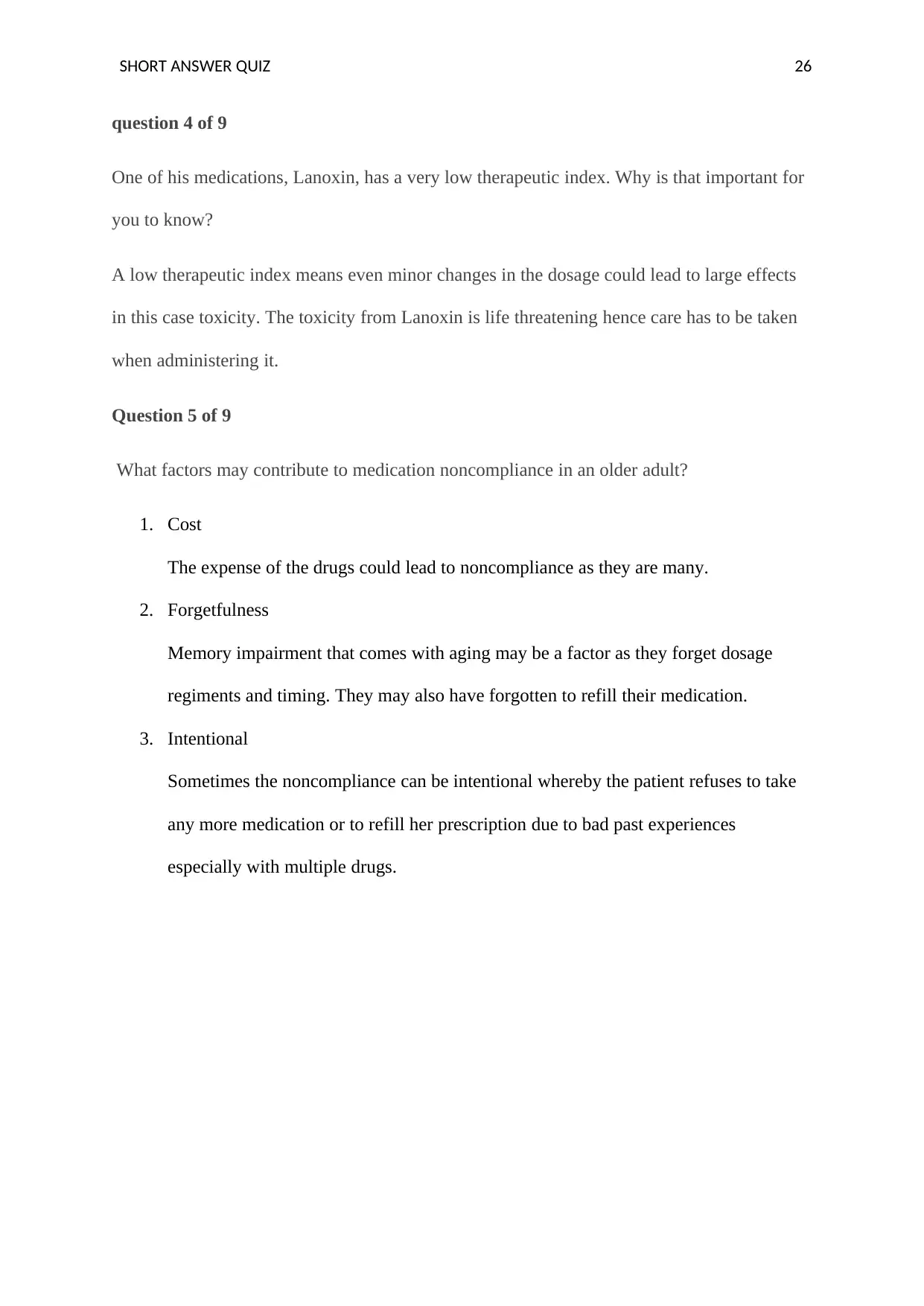
SHORT ANSWER QUIZ 26
question 4 of 9
One of his medications, Lanoxin, has a very low therapeutic index. Why is that important for
you to know?
A low therapeutic index means even minor changes in the dosage could lead to large effects
in this case toxicity. The toxicity from Lanoxin is life threatening hence care has to be taken
when administering it.
Question 5 of 9
What factors may contribute to medication noncompliance in an older adult?
1. Cost
The expense of the drugs could lead to noncompliance as they are many.
2. Forgetfulness
Memory impairment that comes with aging may be a factor as they forget dosage
regiments and timing. They may also have forgotten to refill their medication.
3. Intentional
Sometimes the noncompliance can be intentional whereby the patient refuses to take
any more medication or to refill her prescription due to bad past experiences
especially with multiple drugs.
question 4 of 9
One of his medications, Lanoxin, has a very low therapeutic index. Why is that important for
you to know?
A low therapeutic index means even minor changes in the dosage could lead to large effects
in this case toxicity. The toxicity from Lanoxin is life threatening hence care has to be taken
when administering it.
Question 5 of 9
What factors may contribute to medication noncompliance in an older adult?
1. Cost
The expense of the drugs could lead to noncompliance as they are many.
2. Forgetfulness
Memory impairment that comes with aging may be a factor as they forget dosage
regiments and timing. They may also have forgotten to refill their medication.
3. Intentional
Sometimes the noncompliance can be intentional whereby the patient refuses to take
any more medication or to refill her prescription due to bad past experiences
especially with multiple drugs.
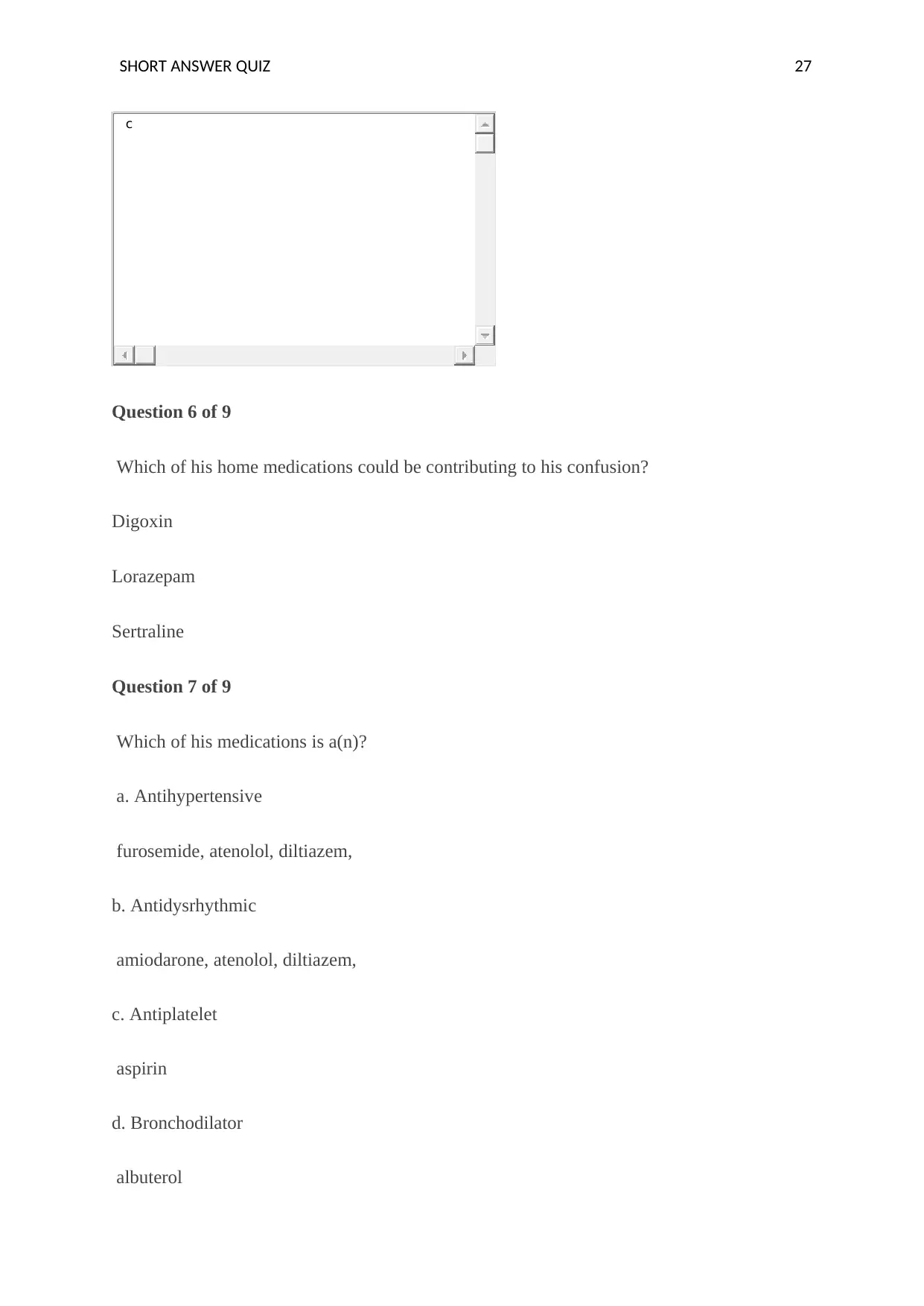
SHORT ANSWER QUIZ 27
Question 6 of 9
Which of his home medications could be contributing to his confusion?
Digoxin
Lorazepam
Sertraline
Question 7 of 9
Which of his medications is a(n)?
a. Antihypertensive
furosemide, atenolol, diltiazem,
b. Antidysrhythmic
amiodarone, atenolol, diltiazem,
c. Antiplatelet
aspirin
d. Bronchodilator
albuterol
c
Question 6 of 9
Which of his home medications could be contributing to his confusion?
Digoxin
Lorazepam
Sertraline
Question 7 of 9
Which of his medications is a(n)?
a. Antihypertensive
furosemide, atenolol, diltiazem,
b. Antidysrhythmic
amiodarone, atenolol, diltiazem,
c. Antiplatelet
aspirin
d. Bronchodilator
albuterol
c
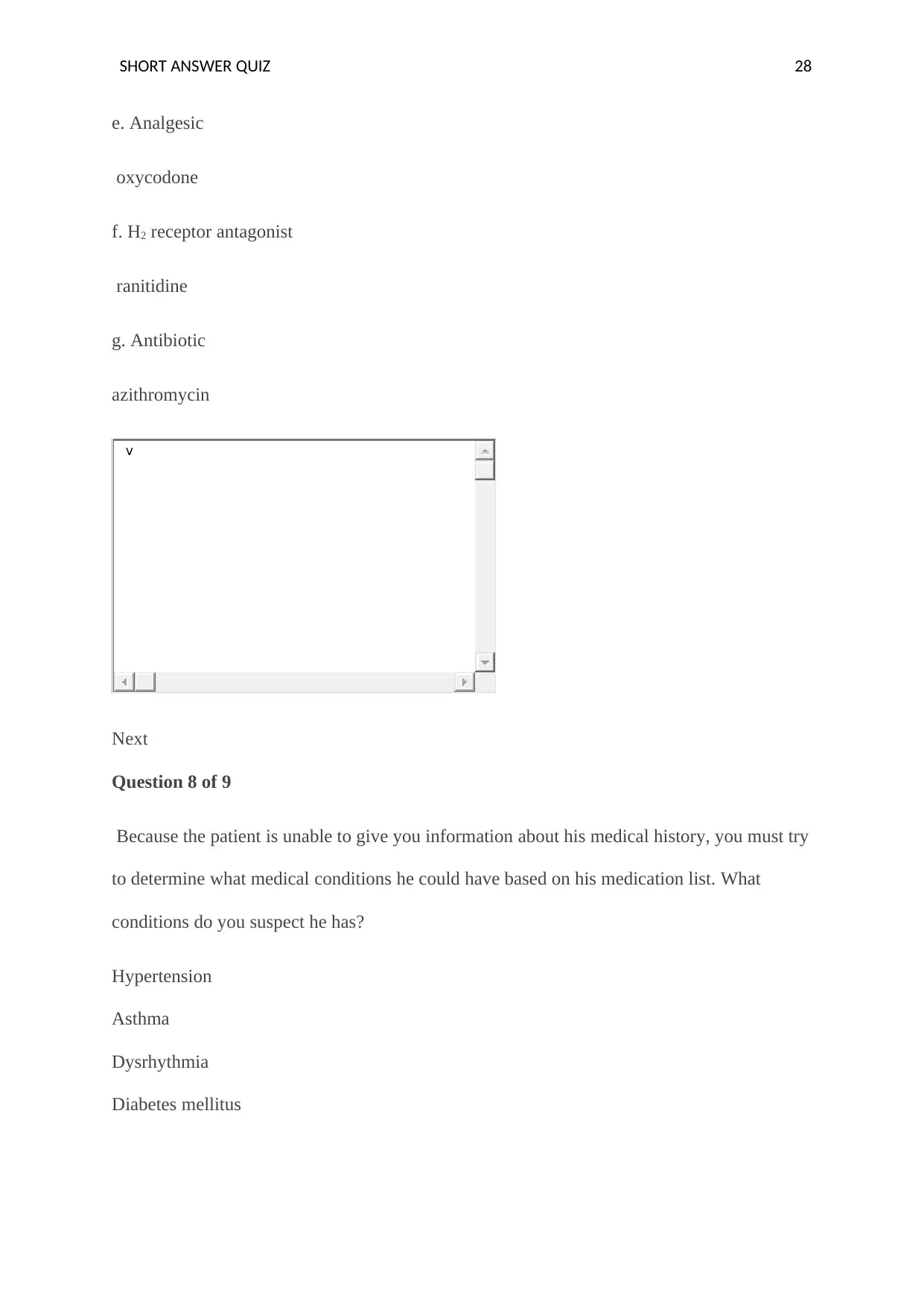
SHORT ANSWER QUIZ 28
e. Analgesic
oxycodone
f. H2 receptor antagonist
ranitidine
g. Antibiotic
azithromycin
Next
Question 8 of 9
Because the patient is unable to give you information about his medical history, you must try
to determine what medical conditions he could have based on his medication list. What
conditions do you suspect he has?
Hypertension
Asthma
Dysrhythmia
Diabetes mellitus
v
e. Analgesic
oxycodone
f. H2 receptor antagonist
ranitidine
g. Antibiotic
azithromycin
Next
Question 8 of 9
Because the patient is unable to give you information about his medical history, you must try
to determine what medical conditions he could have based on his medication list. What
conditions do you suspect he has?
Hypertension
Asthma
Dysrhythmia
Diabetes mellitus
v
Secure Best Marks with AI Grader
Need help grading? Try our AI Grader for instant feedback on your assignments.
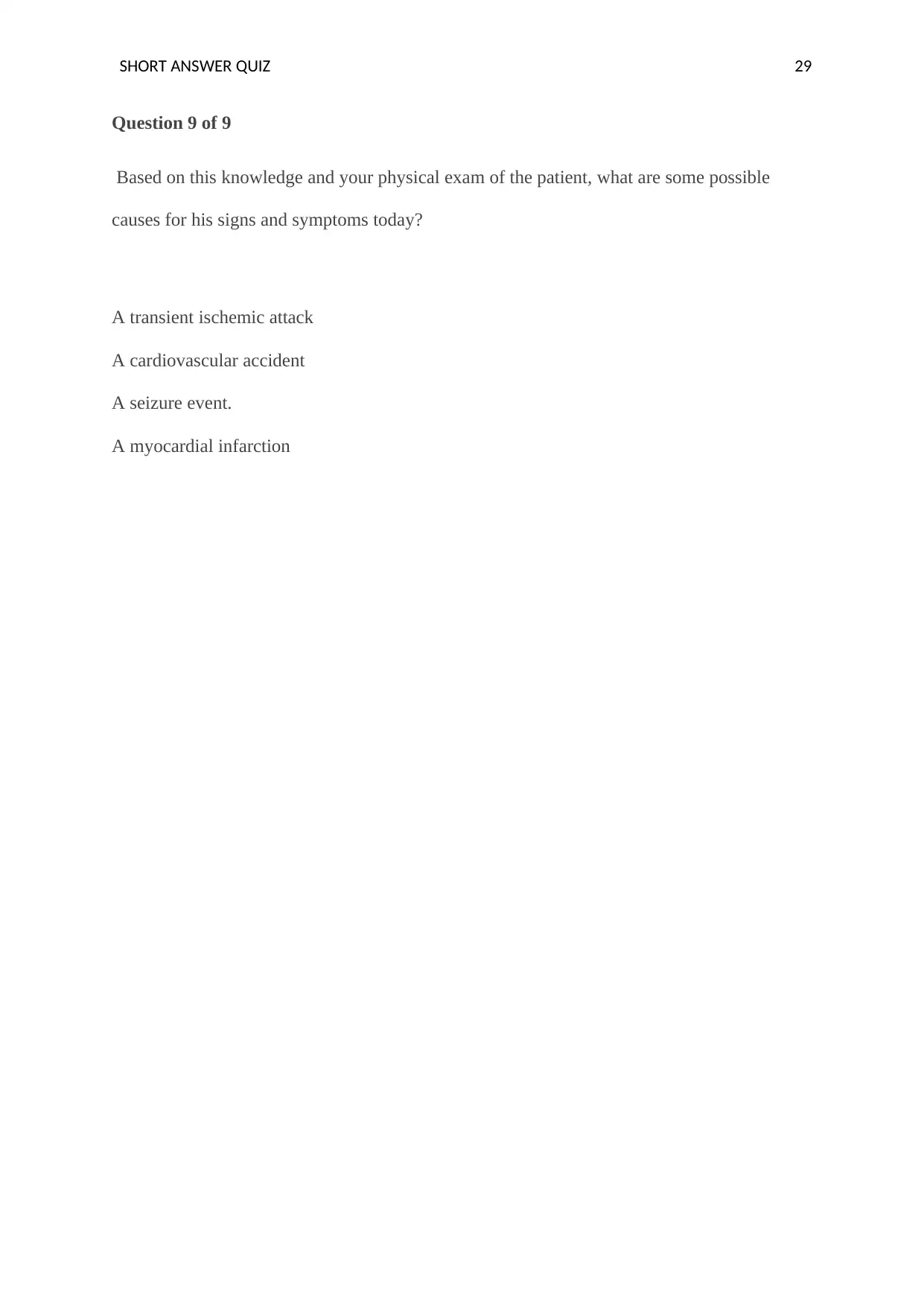
SHORT ANSWER QUIZ 29
Question 9 of 9
Based on this knowledge and your physical exam of the patient, what are some possible
causes for his signs and symptoms today?
A transient ischemic attack
A cardiovascular accident
A seizure event.
A myocardial infarction
Question 9 of 9
Based on this knowledge and your physical exam of the patient, what are some possible
causes for his signs and symptoms today?
A transient ischemic attack
A cardiovascular accident
A seizure event.
A myocardial infarction
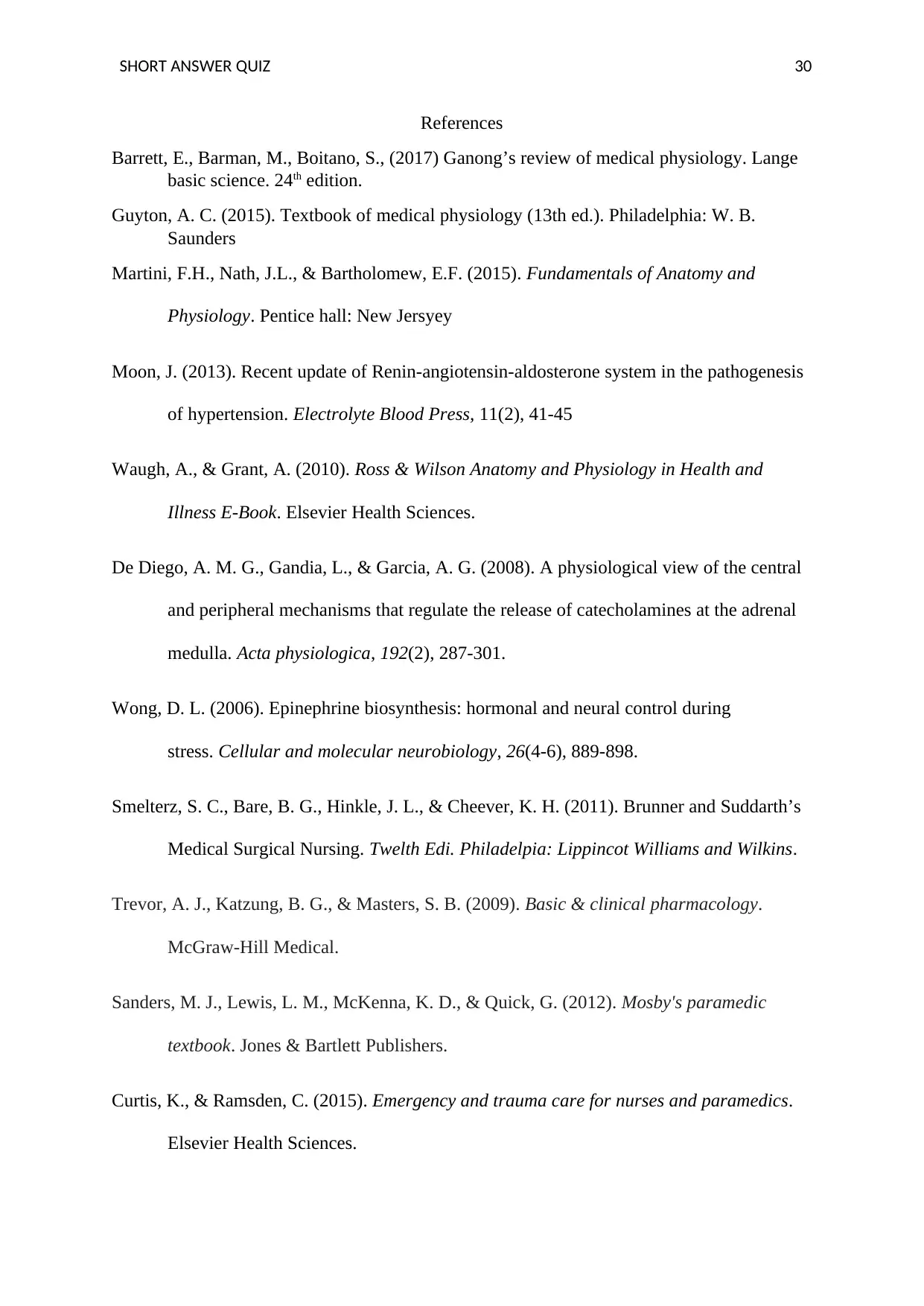
SHORT ANSWER QUIZ 30
References
Barrett, E., Barman, M., Boitano, S., (2017) Ganong’s review of medical physiology. Lange
basic science. 24th edition.
Guyton, A. C. (2015). Textbook of medical physiology (13th ed.). Philadelphia: W. B.
Saunders
Martini, F.H., Nath, J.L., & Bartholomew, E.F. (2015). Fundamentals of Anatomy and
Physiology. Pentice hall: New Jersyey
Moon, J. (2013). Recent update of Renin-angiotensin-aldosterone system in the pathogenesis
of hypertension. Electrolyte Blood Press, 11(2), 41-45
Waugh, A., & Grant, A. (2010). Ross & Wilson Anatomy and Physiology in Health and
Illness E-Book. Elsevier Health Sciences.
De Diego, A. M. G., Gandia, L., & Garcia, A. G. (2008). A physiological view of the central
and peripheral mechanisms that regulate the release of catecholamines at the adrenal
medulla. Acta physiologica, 192(2), 287-301.
Wong, D. L. (2006). Epinephrine biosynthesis: hormonal and neural control during
stress. Cellular and molecular neurobiology, 26(4-6), 889-898.
Smelterz, S. C., Bare, B. G., Hinkle, J. L., & Cheever, K. H. (2011). Brunner and Suddarth’s
Medical Surgical Nursing. Twelth Edi. Philadelpia: Lippincot Williams and Wilkins.
Trevor, A. J., Katzung, B. G., & Masters, S. B. (2009). Basic & clinical pharmacology.
McGraw-Hill Medical.
Sanders, M. J., Lewis, L. M., McKenna, K. D., & Quick, G. (2012). Mosby's paramedic
textbook. Jones & Bartlett Publishers.
Curtis, K., & Ramsden, C. (2015). Emergency and trauma care for nurses and paramedics.
Elsevier Health Sciences.
References
Barrett, E., Barman, M., Boitano, S., (2017) Ganong’s review of medical physiology. Lange
basic science. 24th edition.
Guyton, A. C. (2015). Textbook of medical physiology (13th ed.). Philadelphia: W. B.
Saunders
Martini, F.H., Nath, J.L., & Bartholomew, E.F. (2015). Fundamentals of Anatomy and
Physiology. Pentice hall: New Jersyey
Moon, J. (2013). Recent update of Renin-angiotensin-aldosterone system in the pathogenesis
of hypertension. Electrolyte Blood Press, 11(2), 41-45
Waugh, A., & Grant, A. (2010). Ross & Wilson Anatomy and Physiology in Health and
Illness E-Book. Elsevier Health Sciences.
De Diego, A. M. G., Gandia, L., & Garcia, A. G. (2008). A physiological view of the central
and peripheral mechanisms that regulate the release of catecholamines at the adrenal
medulla. Acta physiologica, 192(2), 287-301.
Wong, D. L. (2006). Epinephrine biosynthesis: hormonal and neural control during
stress. Cellular and molecular neurobiology, 26(4-6), 889-898.
Smelterz, S. C., Bare, B. G., Hinkle, J. L., & Cheever, K. H. (2011). Brunner and Suddarth’s
Medical Surgical Nursing. Twelth Edi. Philadelpia: Lippincot Williams and Wilkins.
Trevor, A. J., Katzung, B. G., & Masters, S. B. (2009). Basic & clinical pharmacology.
McGraw-Hill Medical.
Sanders, M. J., Lewis, L. M., McKenna, K. D., & Quick, G. (2012). Mosby's paramedic
textbook. Jones & Bartlett Publishers.
Curtis, K., & Ramsden, C. (2015). Emergency and trauma care for nurses and paramedics.
Elsevier Health Sciences.
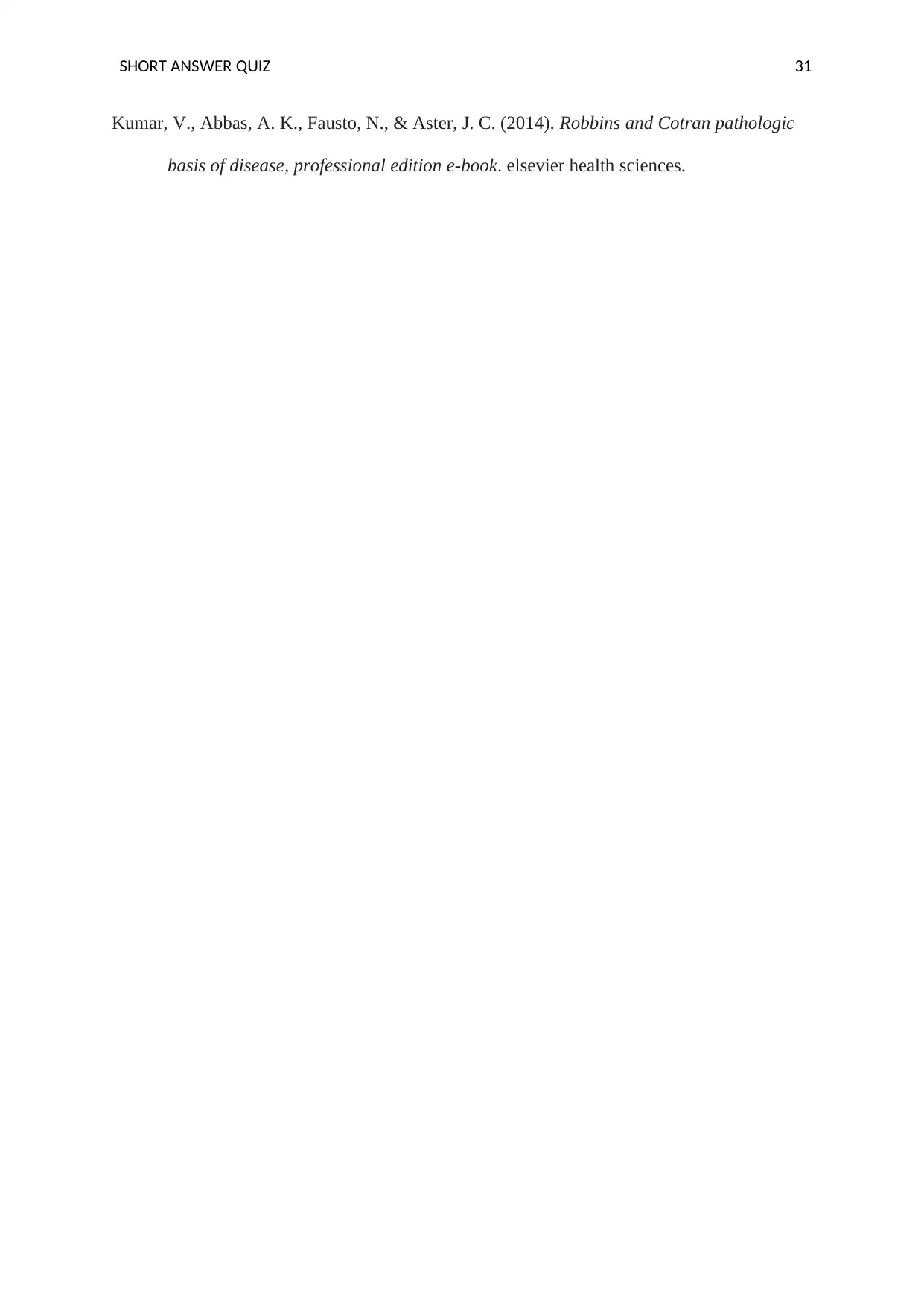
SHORT ANSWER QUIZ 31
Kumar, V., Abbas, A. K., Fausto, N., & Aster, J. C. (2014). Robbins and Cotran pathologic
basis of disease, professional edition e-book. elsevier health sciences.
Kumar, V., Abbas, A. K., Fausto, N., & Aster, J. C. (2014). Robbins and Cotran pathologic
basis of disease, professional edition e-book. elsevier health sciences.
1 out of 31
Your All-in-One AI-Powered Toolkit for Academic Success.
+13062052269
info@desklib.com
Available 24*7 on WhatsApp / Email
![[object Object]](/_next/static/media/star-bottom.7253800d.svg)
Unlock your academic potential
© 2024 | Zucol Services PVT LTD | All rights reserved.


